cardigan





board of trustees
David M. Gregory P’18, Chair
Karl G. Hutter ’92, Vice Chair
Paula R. Glover P’22, Vice Chair
George “Jory” C. Macomber P’12, Vice Chair
Robert V. Chartener ’73, Secretary
Michael B. Garrison ’67, P’94,’96, Treasurer
Christopher D. Day P’12,’13, Head of School
Jeremy T. Crigler ’79
George Davis P’22
Stewart S. Dixon, Jr. ’80
Ethan Frechette
Christopher “Kip” R.F. Hale ’95
Guifang “Linda” He P’19,’22
Dr. Robert F. Kenerson H’04
F. Corning “Kim” Kenly III ’68
Christopher J. King ’79
Heather Knapp P’20,’21
Doowhan Ko P’23
P. Edward Krayer ’82
Tyler L. Lewis P’24
Jessica Abramson Lott P’23
Candyce Martin P’14
Pornphisud “Paul” Mongkhonvanit P’20
Malcolm C. Moran ’64, P’00
Dr. Richard D. Morrison ’50, P’76,’82
Marc Porcelli ’95
Jeffrey M. Roberts P’21
Kristi Ross P’18
Christopher M. Taliercio ’95
Alva H. Taylor, Ph.D. P’22
Jonathan N. Wakely ’75
Laura F. Waldron
Mario Zambrano ’95
Daniel M. Zinsmeyer ’83
trustees emeriti

David H. Bradley, Esq. H’13, P’78
Burton E. McGillivray P’07,’09,’09
Diane G. Wallach H’16, P’06
e Chronicle Fall 2022
in every issue 1. letter from the editor: A glimpse behind the curtain at the makings of every issue. 2. letter from the head of school: What’s on the mind of Head of School Chris Day? 32. on the point: What’s new on campus? 42. from marrion field: Keeping score and touching base with the Cougars. 50. history’s mysteries: A visit to Cardigan’s archives. 52. founders path: Updates from the trustees and founders of the School. 56. alumni drive: Catching up with alumni around the bend and around the world. 66. cardigan connections: From your classmates, in their own words.
in this issue
4. commencement 2022: Congratulations to the Class of 2022! We couldn’t have asked for a better day to celebrate! From the boutonnière pinning and the Alumni Tie Ceremony to the presentation of diplomas and the receiving line, the sun shone brightly as we recognized the achievements of this impressive group of leaders and scholars. 20. habits of learning for all cardigan students: For this feature we invite you into the Cardigan classroom to learn alongside our students. The lessons and their objectives are varied, but girding each one are the School’s Habits of Learning, targeting specific skills that challenge and prepare our students for lifelong learning.
editorial office: Cardigan Mountain School, 62 Alumni Drive, Canaan, NH 03741; 603.523.3559; communications@cardigan.org. editors: Director of Communications and Marketing Chris Adams; Assistant Director of Communications Emily Magnus. guest contributors: Jer Shipman ’00 and Judith Solberg. photographers: Chris Adams, Cynthia Day P’12,’13, Martin Grant, Emily Magnus, and Stephen Solberg. The Cardigan Chronicle is published bi-annually by the Communications Office for alumni, parents, and friends of the School. The magazine is printed by R.C. Brayshaw and Company on sustainably produced, chain-of-custody stock certified to Forest Stewardship Council (FSC) standards.

For
more information about why our Heritage Society members choose to support Cardigan Mountain School, or how to do so yourself, visit plannedgiving.cardigan.org or contact Sandra Hollingsworth at shollingsworth@cardigan.org or 603.523.3745. Please note: Cardigan Mountain School does not provide tax advice. For your gift planning, please consult a financial advisor to discuss what will work best for you and your family.

The Heritage Society recognizes those who make a bequest or planned gift to Cardigan. Their generosity expands opportunities for future generations of students. With gifts of all sizes, members of The Heritage Society honor and sustain our mission, inspiring others to support our School. Like the School’s founders, theirs is a legacy with continuing impact. We are honored to represent their philanthropic priorities in perpetuity, and are deeply grateful for the opportunity to assume that trust and responsibility. Gift planning? Hoping to leave a legacy? Consider becoming a member of Cardigan’s Heritage Society.
Courage in Unexpected Places
(found on page 20). “It was 2008 and the economy was crashing, and [Head of School] Dave McCusker ’80, P’09,’10 was asking me to help him get rid of a fee-based program and replace it with a program for all students that wasn’t going to generate any income,” Mr. Caprow explained to me. “It was only my third year at Cardigan and Dave put his trust in me and several others to develop a completely new approach to study skills at Cardigan.” e possibility of failure was real, and very public. anks to Mr. Caprow’s quiet determination and unwavering leadership, Cardigan’s PEAKSprogram evolved and continues to thrive, still preparing middle school boys for life beyond e Point.
When I look back over the many months it takes to produce an issue of the Chronicle, and I think about the countless conversations I have with the people in this community, there are always details that overlap unexpectedly, adding surprising nuances and subtleties to the stories within each magazine; history repeats itself, characters long forgotten resurface, faces in archival photographs look eerily similar to faces in the present. While preparing for this issue, I couldn’t help but notice how Cardigan’s Core Value of Courage was playing out in multiple stories I was writing, both past and present.
Take for example the Classes of 2024 and 2025 and Director of Gates Eric Escalante P’20,’22. Ushering an idea from its first spark to a working prototype and presenting that idea to a live audience takes courage; I remember being 11 and 12 years old, and I avoided presenting to my peers and teachers at all costs. ese young scholars, however, stood tall during the Charles C. Gates Invention & Innovation Competition, looking directly at their audience and giving articulate sales pitches without hesitation; Wallach was filled with an energy and enthusiasm that any high-tech cutting-edge engineering firm would welcome in its lab. e sixth and seventh graders are an impressive bunch with more than a modicum of perseverance and enthusiasm, and yes, courage to literally try something new. You can learn more about their Gates inventions on page 32.

Assistant Dean of Academics and PEAKS™Department Chair Jarrod Caprow’s story begins with courage as well. He was one of several faculty members responsible for developing PEAKSand I interviewed him about the origins of the Habits of Learning for the magazine’s feature

en there was the unexpected letter I received in June from alumnus Richard Meynell ’59 in which he shared his memories from his time at Cardigan. As with many boys, his start at Cardigan was not easy. A self-confessed loner, he found it difficult to make friends and spent much of his first year struggling with homesickness. While he recalled many good memories—sailing and canoeing on the lake, playing imaginary soldiers in the woods in all seasons, listening to his English teacher Mr. Brayshaw read Greenmantle by John Buchan—in his letter he confessed to a sadness at the time that he found difficult to express openly to his peers and dorm parents; he had lost his mother to cancer prior to attending Cardigan and continued to mourn for her during his first year. At Cardigan, he found comfort in an unlikely place: “I sought refuge in the top of a large white pine that stood in the bottom of the field behind Brewster Hall. Somehow I had the feeling that that tree was motherly. She consoled me with gentle whispers…To this day I remain grateful and feel very fortunate for having her in my life; that I found a second mother in a tree.” It must have taken a great deal of courage for Richard to persevere through his loss and eventually to discover a path forward.
Courage is oen seen as a very public and masculine trait, one that involves the gnashing of teeth and deep guttural exclamations—the kind of energy it takes to fight a dragon. But there’s a quieter version of this trait that I frequently encounter at Cardigan, behind the scenes, persevering and persisting where there is no one to witness its strength and power. Fighting dragons is all well and good, but I am proud to work in a community that understands a different kind of courage and nurtures it in unexpected places. r
Emily Magnus, Editor emagnus@cardigan.org
1
Sixth and seventh graders, who courageously embraced the creative process during the spring Gates competition
e Bullseye of Our Work
I’ve oen heard that championships are won on the practice field, long before the actual game is played. e same could be said for an artistic performance, a debate, or our value system—as individuals and as a community. Similarly, the ancient Stoics believed that the phrase “It’s just the way I am,” or “I was born that way,” was spurious, and a far too simple way of accepting what one has “become.”

At Cardigan—and in the Cardigan community—our work focuses on developing the mind, body, and spirit of our boys. While many parents and educators out there bemoan teaching and coaching middle school boys and see it as a hair-pulling exercise in frustration, at Cardigan we recognize this developmental stage as the bullseye of our work. It’s work that requires a long view—discarding immediate gratification for perseverance and patience—but it’s also work that is well worth the effort.
Peninsulating into the clear water of Canaan Street Lake and nestled under the shadow of our namesake, Mount Cardigan, our 500+ acre rural campus, and the wonderful facilities we’ve created to serve us, are our laboratory. Far from any Starbucks or big box stores, and free from the addictive distractions of our hand-held electronic devices (Can we even call them phones anymore?), our programs slow time down and work on the fundamentals in order to better develop more sophisticated skills.
Central to that work are Cardigan’s Habits of Learning: Growth Mindset, Self-Awareness, Co-Existence, Critical inking, Communication, Ownership, and Creativity. e first iteration of these habits was written in the late 2000s as PEAKSwas developing into one of Cardigan’s signature programs. While the habits didn’t necessarily change the way the faculty were teaching, they gave, and continue to give, students and faculty a common language to talk about the progress students make as
they mature. Posted in classrooms throughout the academic buildings, the skills are formative rather than summative, allowing for the growth and development of good habits that set students up for a lifetime of learning. Cardigan boys are far from complete when they don their white coats and alumni ties, but they possess a deep awareness of self and have agency; they understand that the route to success has no shortcuts and that luck is the residue of hard work.
For the last few years we’ve all existed in a global pandemic, which not only claimed millions of lives, but also, somewhat less noticeably, claimed years of valuable in-person learning and socialization for kids. at, combined with the breakneck pace of life in which many of us find ourselves of late, has resulted in a loss of the patience and persistence needed to develop kids into mature adults, capable of collaboration, critical thinking, and open-minded decision making. Cardigan’s Habits of Learning, however, have stood the test of time and even through the pandemic, have been a firm foundation on which our faculty teach and our boys learn. In the pages of this issue of the Chronicle you’ll see examples of how, as one of our founders said, “Only on the basis of a good idea,” this school continues to serve boys in the right way, the Cardigan Way r
 Christopher D. DayP’12,’13 Head of School
Christopher D. DayP’12,’13 Head of School
2

3


4
commencement 2022

5
By ursday,
May 26th, only the ninth graders remained on campus, spending the last three days before Commencement together, one last time. eir days were filled with student vs. faculty basketball and baseball games, Green and White Competitions, and cookouts. ey also climbed to the summit of Mount Cardigan, gathering on the mountain’s rocky dome to celebrate all they learned and shared together and to express their gratitude for their time at Cardigan Mountain School.




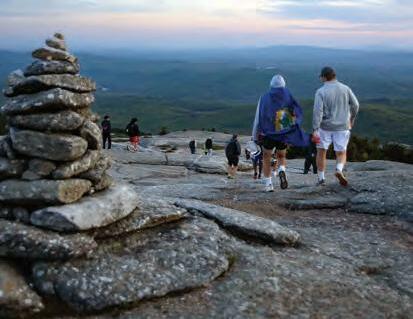
6

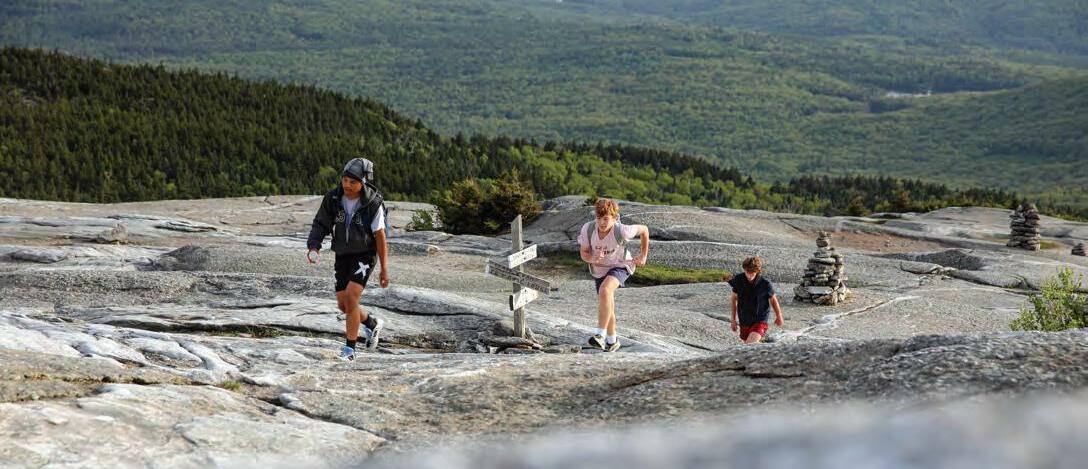
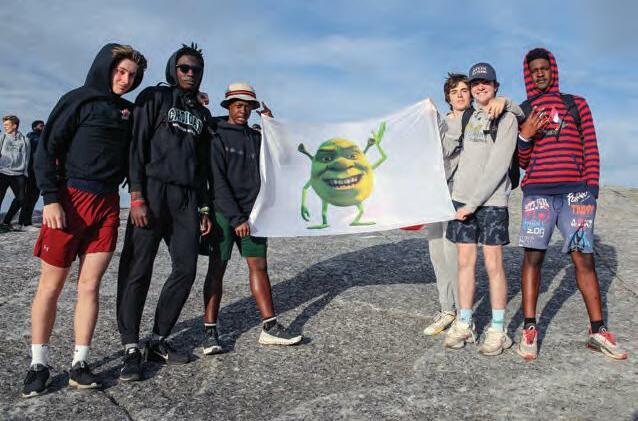

7
e Graduates


nicolas flores Mexico City, Mexico christian gibran garcia islas Mexico City, Mexico layton elliott glover Bowie, Maryland andre gonzalez rodriguez San Pedro Garza Garcia, Mexico reid tanner gueldenzoph* Meriden, New Hampshire
grady joseph allison Kennett Square, Pennsylvania iñigo arsuaga de haro Mexico City, Mexico francisco artigas bay, jr. Aguascalientes, Mexico keonha bae* Seoul, South Korea landon corey beattie Enfield, New Hampshire diego belden de la vega San Pedro Garza Garcia, Mexico daniel benavides de alba Aguascalientes, Mexico robert emerson dard burns Locust Valley, New York jaeson david cabrera Boston, Massachusetts patricio cantu villarreal San Pedro Garza Garcia, Mexico rodrigo carrandi garza* San Pedro Garza Garcia, Mexico jingkun chen Xiamen, China
hexiang cheng Shanghai, China daniel james commerford Bow, New Hampshire jackson dean davies* Meriden, New Hampshire carter cain davis* Decatur, Georgia enrique de alba g. Mexico City, Mexico harold de rouvray bruck San Francisco, California j. hudson deck Manchester, Vermont pablo del paso pena Mexico City, Mexico aidan joseph doyle Amherst, New Hampshire mateo escalante* Canaan, New Hampshire
jeronimo escobar vargas Mexico City, Mexico robert christopher fawcett Duxbury, Massachusetts
ho seok ham* Seoul, South Korea hudson cornelius heinemann Wappingers Falls, New York blake alexander hodges Dallas, Georgia koon chung hui* Hong Kong, China spencer wyatt hutchinson Canaan, New Hampshire hanzhi kang Guangzhou, China solmon kim Busan, South Korea jason jung lee Seoul, South Korea junhyeong lee Seoul, South Korea sanggyu lee Incheon, South Korea zhefu lei Shenzhen, China gilbert abraham lignell Hyvinkää, Finland su lin Shenzhen, China jiajun liu* Beijing, China sechang mah Seoul, South Korea beau magnus john hart mcarthur Toronto, Canada ian james mcdonnell* Chevy Chase, Maryland
8
mateo merino jimenez, jr. Zapopan, Mexico
preston carter merrick Laurelton, New York sanders arthur morris Birmingham, Alabama
james ford morse Rye, New Hampshire
joseph flanagan morse Rye, New Hampshire
john william murphy iv* Grantham, New Hampshire liam joseph murphy Concord, New Hampshire treva murphy Manchester, New Hampshire carmelo n’kumbu Mascouche, Canada

javier ochoa palme Spring, Texas
zoumana ouattara New York, New York paul michael parash Southampton, New York landon ryder paul Bulls Creek, Canada mitchell noah peurach San Francisco, California
zeze leon probstein Chestnut Hill, Massachusetts binxiu qin* Shanghai, China
william phipps rice iii North Woodstock, New Hampshire alejandro rojas velasco Mexico City, Mexico
ethan jon roy Williston, Vermont
alberto ruenes naser Leon, Mexico
teo kent ryder Breckenridge, Colorado
churchill tash salathé Andover, New Hampshire
parker xavier saunders Hopkinton, New Hampshire alejandro salvador schlesinger abud Mexico City, Mexico bolin shang Beijing, China yejoon sim Seoul, South Korea gustavo struck ramirez* Mexico City, Mexico zhiyuan sun Shanghai, China conor andrew szwez Arlington, Virginia domineaq eric taylor West Lebanon, New Hampshire gabriel ayala taylor Hanover, New Hampshire zimo tian Beijing, China xuanzhe wang* Shanghai, China
carter warren Woodstock, Vermont
james michael willett Arlington, Massachusetts
stuart james windsor Youngsville, Louisiana yuheng yuan Irvine, California huijing zhang Beijing, China zeyu zhang Shanghai, China yutong zhao Beijing, China
*Indicates membership in National Junior Honor Society
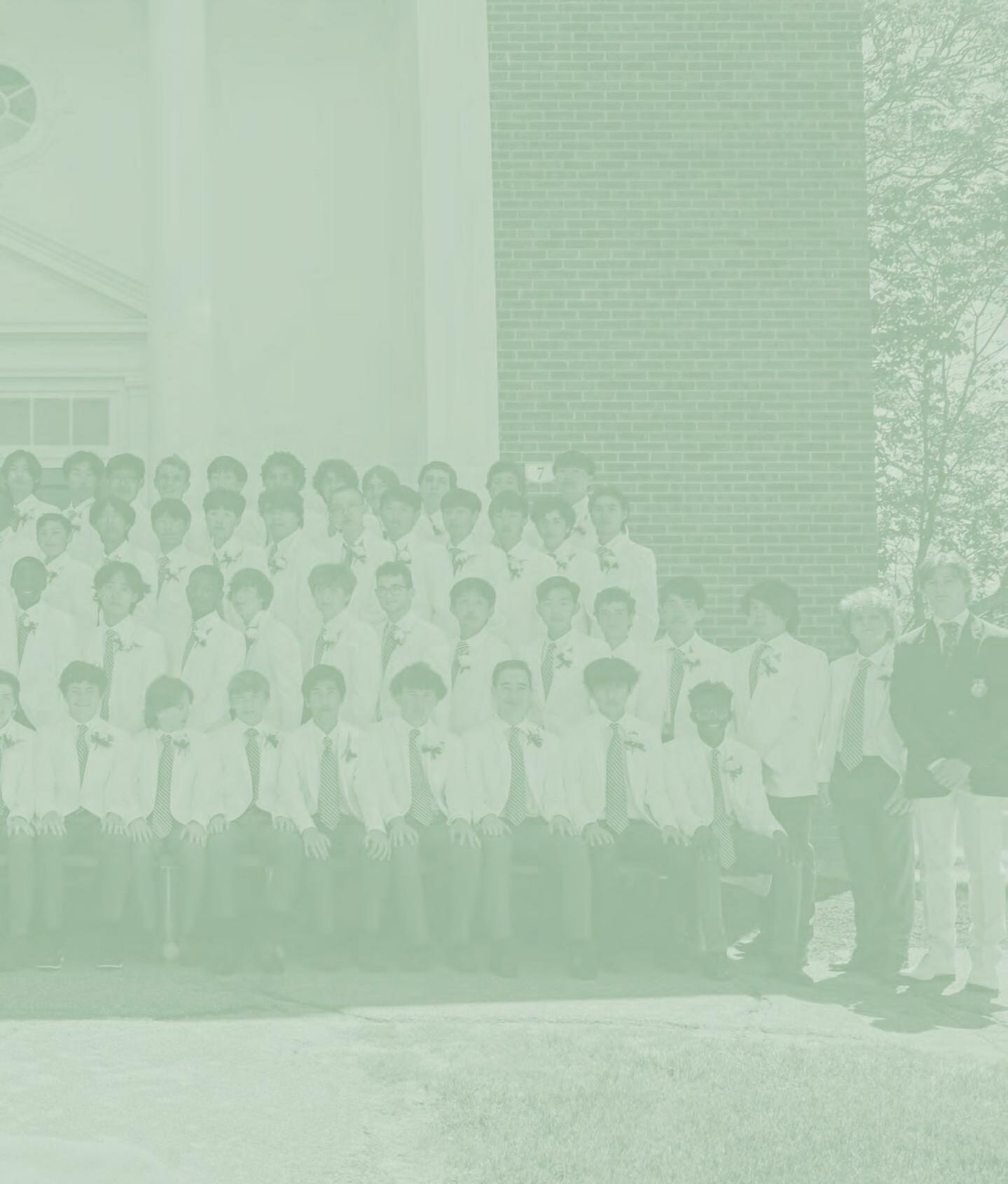
9
For the first time this year, families were invited “backstage” to help the boys secure their boutonnieres and check their commencement attire. With a cloudless blue sky and the green grass of Marrion Field for a backdrop, it was the perfect opportunity for students to take photos with their families, roommates, favorite teachers and advisors, and even Joe Cougar.



You, their families, and we, their Cardigan adults, have come to the end of a wonderful collaboration. You lent us your boys: rough-hewn, perhaps, but sturdy and willing to be sculpted and burnished into vessels of integrity, courage, compassion, and respect. Having grown to love and appreciate the unique temperament of each, we now stand ready to release them back into your care as young men.

10
– Cheryl Borek P’10,’12,’15, – DireCtor of SPiritual life
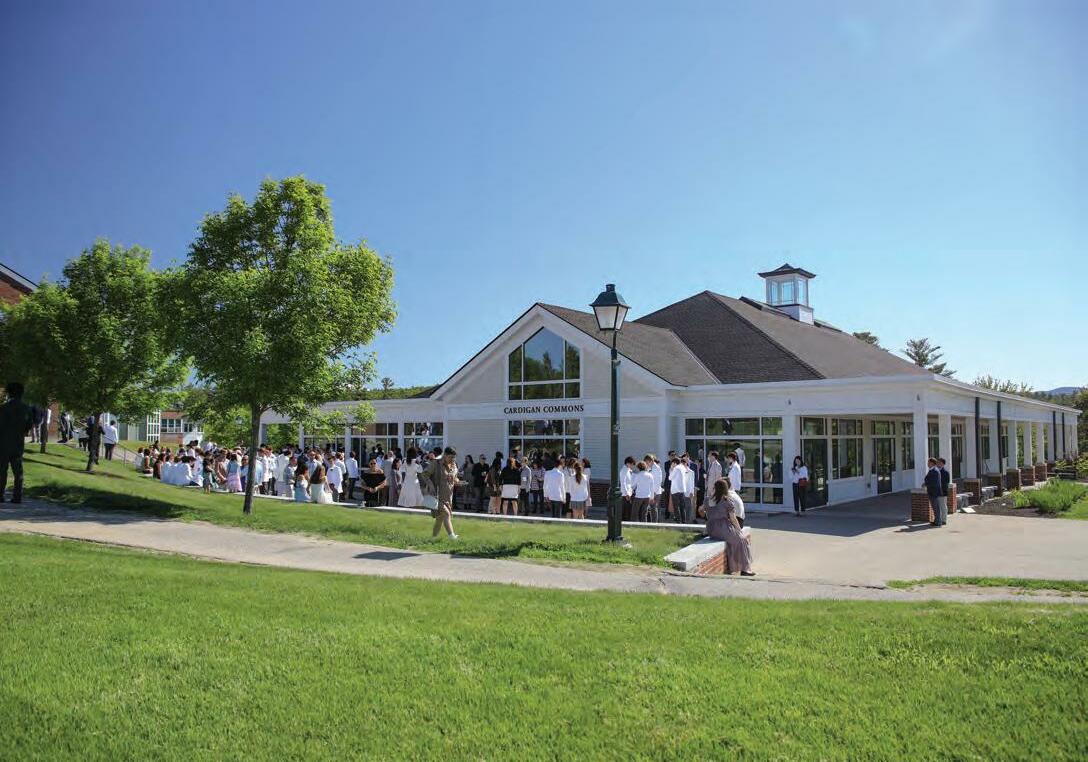



11
e Cardigan brotherhood remains strong through the generations. Before processing into Commencement, the Class of 2022 gathered in front of Clark-Morgan Hall and received their traditional green and silver ties from a host of alumni. Brothers, fathers, faculty, one former head of school, and many friends were included in the receiving line waiting to congratulate the boys.


At Cardigan we use our Core Values of compassion, integrity, respect, and courage as the root of everything we do. Parents, your sons have not mastered any of it—no more than any adult here has—but, and this is one of the secrets of this magical place, they know that actively and intentionally aspiring to live one’s life by a set of values shared by others…that is a worthy pursuit.
– ChriS Day P’12,’13,
– heaD of SChool


12
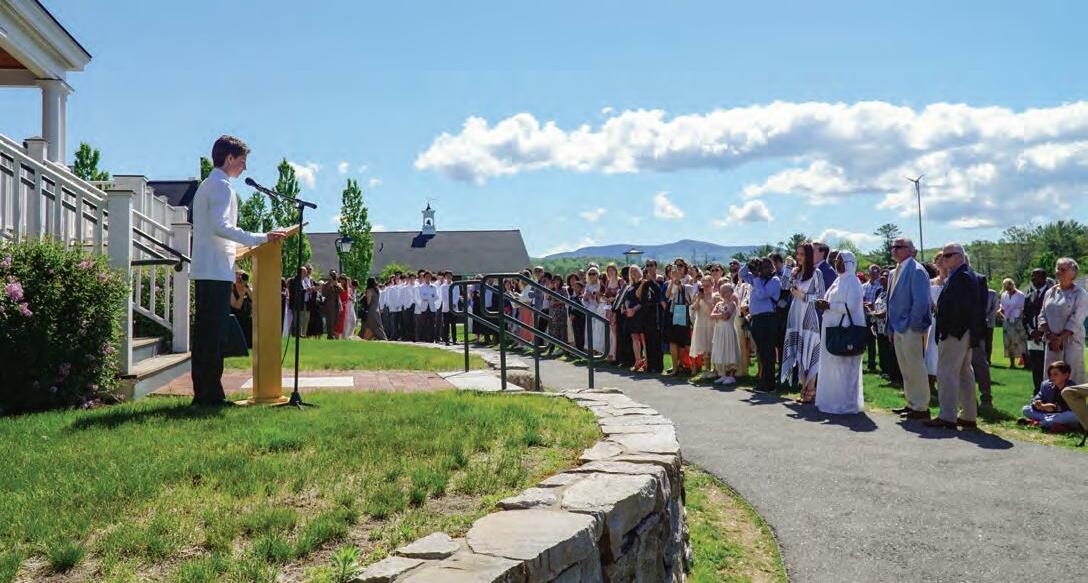

13
To accept and to respect people who are different from you, we must start at some point. Luckily at Cardigan, you had the gift of exposure. I now invite all of you to take a leap of faith. Find beauty in otherness, learn to appreciate people in ways that you’ve never appreciated them before.

– yifu Mu ’14, – CoMMenCeMent SPeaker

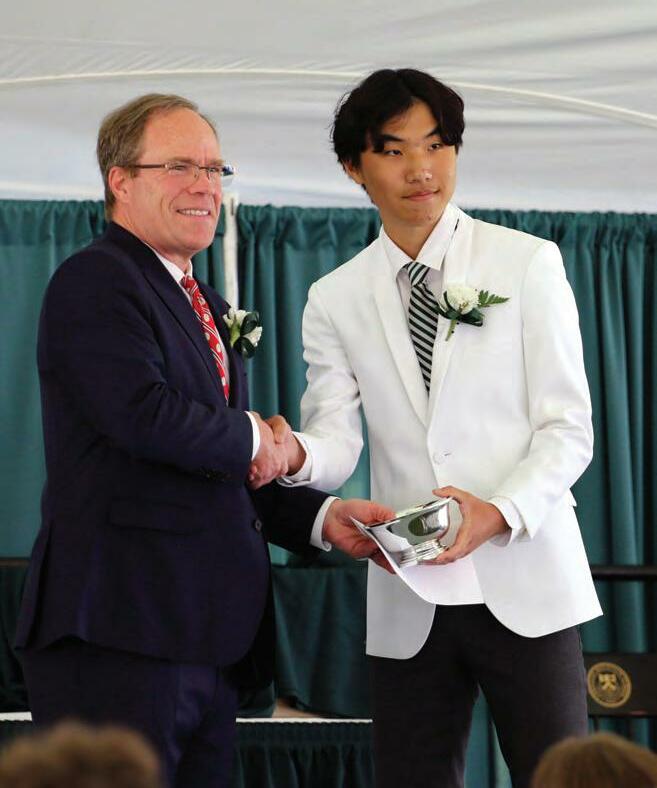

14
Commencement Awards and Prizes
the caldwell prize
jackson dean davies
The Caldwell Prize is awarded to the senior who has shown outstanding athletic achievement and sportsmanship.
the dewar prize jason jung lee
The Dewar Prize is awarded annually in honor of Dr. and Mrs. Cameron K. Dewar to the member of the senior class with the highest academic standing.
the founders prize mateo escalante
The Founders Prize is awarded to the senior who has the will to complete any project, regardless of the difficulties encountered, without thought of personal gain, and whose objective is a job well done in the same approach that characterized the life of Harold P. Hinman, one of the founders of Cardigan Mountain School.
the hinman prize
treva murphy
The Hinman Prize is given annually in memory of Mr. and Mrs. Harold P. Hinman to the senior who, in the opinion of the faculty, by industrious application to his studies, through his attitude on the playing field, and by his behavior and integrity, most nearly approaches the ideals of manhood as conceived in the
minds of the founders of Cardigan Mountain School.
the norman and beverly wakely prize diego belden de la vega
The Norman and Beverly Wakely Prize is awarded by the Class of 1989 to the senior who, in the opinion of his classmates, best upholds the tradition, spirit, and pride of Cardigan Mountain School, thus making every day “a beautiful day in New Hampshire.”


the pannaci memorial award rodrigo carrandi garza
The Pannaci Memorial Award is awarded annually by the Class of 1959 as a memorial to Karl J. Pannaci ’59, to that member of the senior class who, in the eyes of his fellow students, has achieved the best attained ideals of honesty, integrity, leadership, and general social and spiritual adjustment.
the skibiski memorial award jaeson david cabrera
The Skibiski Memorial Award is given as a memorial to Michael R. Skibiski to that member of the senior class who has shown the greatest progress during his Cardigan Mountain School years.
the william knapp morrison award sanders arthur morris
The William Knapp Morrison Award is presented to the senior who, in the opinion of the students, best exemplifies the spirit of Willie Morrison ’82 in academics, athletics, and as a campus citizen.
faculty prizes keonha bae jackson dean davies su lin
gustavo struck ramirez Awarded to ninth-grade students who, in the opinion of the faculty, have made special contributions to Cardigan Mountain School.
the gilbert family service award
chandra and george davis p’22 yubing cheng and linda he p’19,’22 The Gilbert Family Service Award is awarded annually in honor of the extraordinary volunteer efforts of Maureen and Andy Gilbert—parents of Nate ’08, Jake ’10, and Max ’13—to the ninth-grade parents whose service to the Cardigan Mountain School community has been exceptional.
15
If you do not encounter Cardigan principles where you land in the future, seek to be the example, which would make our Cardigan brotherhood proud. Our voices have to resound loud enough to break down walls of hatred yet be sensitive enough to erect bridges of love and hope…And when you feel like giving up, remember my story and then reach out. I will continue to uphold my brotherly duties and will always be there for each of you in any way I can.
 – Preston Merrick ’22, – school leader
– Preston Merrick ’22, – school leader
16
Secondary School Destinations
Avon Old Farms School (5)
Blair Academy
Brooks School (3)
Canterbury School
Choate Rosemary Hall
Cranbrook School
Episcopal High School
Groton School
The Hill School
Holderness School
The Hotchkiss School (2)
Kent School (3)
Kimball Union Academy (4)
The Loomis Chaffee School
Mercersburg Academy (3)
Middlesex School (3)
Moses Brown School
Northfield Mount Hermon School
The Pennington School
Phillips Academy Andover
Phillips Exeter Academy (2)
Pomfret School
Proctor Academy (3)
St. Andrew’s School (Delaware)
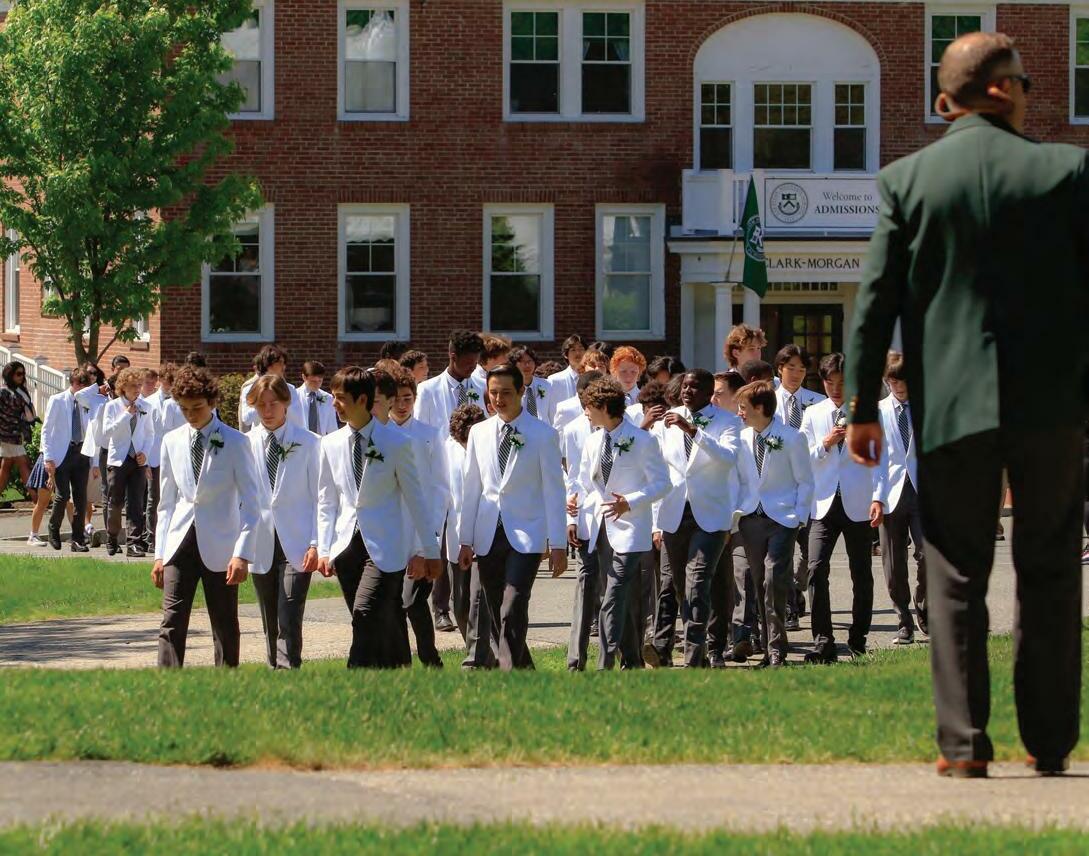
St. George’s School
St. John’s Preparatory School (2)
St. Mark’s School (Massachusetts) (3)
St. Paul’s School (4)
Salisbury School
Stanstead College
Stevenson School
The Taft School
The Thacher School (2)
Virginia Episcopal School
The Webb Schools
Westminster School (2)
Westtown School
Wilbraham & Monson Academy
The Williston Northampton School
17
It was a day filled with joy and celebration as we honored the hard work of the Class of 2022. We know they are destined to accomplish great things, and we can’t wait for them to return and tell us all about their grand adventures!



18
And I will relate what my son, who is off to college this fall, tells me: the importance of Cardigan to you will grow over time…I am an unabashed cheerleader for Cardigan because I know it changes lives, because I don’t think there is another place like it, and because we need what Cardigan delivers now more than ever.

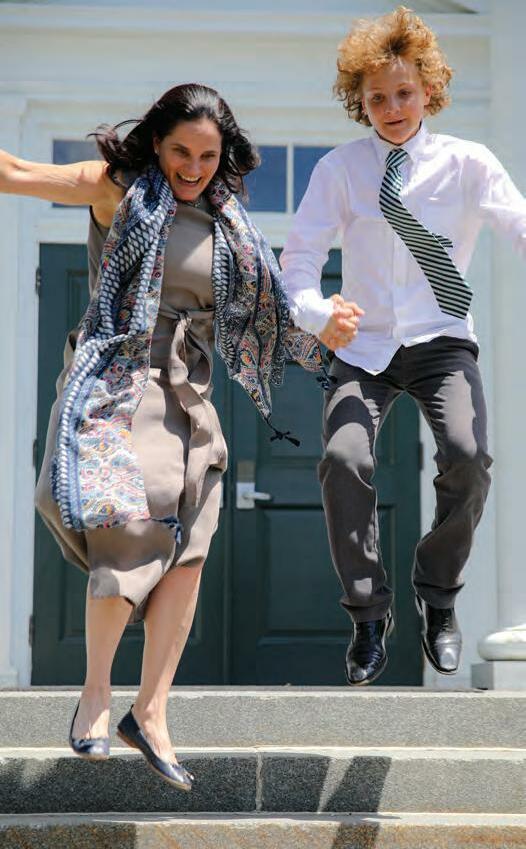


19
– DaviD GreGory P’18, – BoarD Chair

20
Habits of Learning for all cardigan students


by emily magnus
The Cardigan Classroom defies simple desCripTors, refusing To be defined by one TeaChing meThod or philosophiCal model. Rather, each Cardigan classroom is different, determined by teachers, students, lessons, and countless other variables. Wander the halls of the academic buildings and in one room you might see students preparing for a simulated town hall meeting during which they will debate the pros and cons of single-use plastics. In another classroom, students might be working out math problems on individual whiteboards, or participating in literature circles, or deciding where on campus it would be best to install a butterfly habitat. Other classrooms might even be empty, the students spilling out into the hallway to test their Pinewood Derby cars or Gates prototypes. And outside you might find still other students, observing the campus’s natural ecosystem and gathering data for a lab experiment, heads bent in tight clusters over samples dredged from the bottom of Canaan Street Lake. The lessons are as varied as the individual teachers and students and learning objectives.
There’s one thing, however, that remains consistent: Cardigan’s Habits of Learning. Cardigan’s Habits of Learning establish the foundation for every lesson—whether it’s a beginning Spanish lesson on vocabulary, an advanced algebra lesson on logarithms, or an elective art class on digital photography. While sometimes overt and the focus of a lesson, other times the Habits of Learning are more subtle, providing a backdrop for more complex topics. In the following pages, we share with you just a few lessons in which Cardigan boys will engage during their time on The Point and how the Habits of Learning become a part of every classroom experience.
21
habiTs of learning for all Cardigan sTudenTs
growTh mindseT
Students will focus on improvement and understand that intelligence can be developed through problem solving, resilience, and open-mindedness. self-awareness
Students will manage themselves and reflect on their decisions.
CoexisTenCe
Students will peacefully and productively collaborate with others.
CriTiCal Thinking
Students will question and analyze information to draw conclusions.
CommuniCaTion
Students will articulate ideas with clarity and precision through a variety of media.
ownership
Students will advocate for themselves and take responsibility for their life and learning.
CreaTiviTy
Students will explore and imagine.
Mythology: If You Hear Something, Say Something
subjeCT: Latin grade: All Levels TeaCher: Cooper Hemphill habiTs of learning: Growth Mindset, Critical Thinking
Once a week Mr. Hemphill includes a mythology day in his curriculum, sharing stories from ancient mythology that use guiding Latin sentences and demonstrate the grammar the students are learning.
“As we read through the ancient stories,” says Mr. Hemphill, “I encourage my students to speak up, and even interrupt me, if they see or hear an injustice in the story.”
Take, for example, the story of Phaethon, in which Phaethon asks his father Phoebus if he can drive the sun chariot for one day. Unfortunately, Phaethon is completely inexperienced and can’t control the fiery horses. As they veer wildly off course, the horses and chariot swing so close to Earth that they scorch a wide swath of land across Africa, creating the Sahara Desert. Alarmed by the destruction and wishing to prevent further damage, Jupiter strikes Phaethon with a lightning bolt, killing him instantly. This tale was used to explain not only the existence of the Sahara Desert but also the dark skin of the African people.
“We discuss how at the time Romans didn’t understand how deserts work, and so they created assumptions based on the logic of the time,” says Mr. Hemphill. “Then we can talk about how harmful misinformation can be when it gets spread around as fact, especially in a population that didn’t have any different explanations to turn to. My hope is that in addition to developing students’ understanding of the Latin language, our discussions about the ancient world will help them notice some of the subtler injustices that are pervasive in today’s society.”
22
Art Activism
subjeCT: Visual Arts grade level: Eighth TeaCher: Nina Silitch P’19,’21 habiTs of learning: Growth Mindset, Critical Thinking, Communication, Creativity
“Remember: People take action and make decisions based on emotion above all else,” reads the eighth-grade art assignment. “And studies have shown that art impacts our emotions. Use this to your advantage in your artwork.”
This assignment asks students to choose an important social issue, research that topic, and create a piece of art that expresses a clear position through visual symbolism and ideas. Last fall, the students’ projects included pieces on depression, gun violence, pollution, the pandemic, child soldiers, the separation of families divided between North and South Korea, and much more. In their accompanying written artist statements, students not only shared what they learned about their chosen issue but also explained their artistic process and any setbacks they had to overcome.

I wanted to Illustrate the realIstIc ways people act when they confront coVId, and among those, I wanted to emphasIze that In front of the deadly dIsease, fIghtIng and arguIng do not help. although I drew a dystopIa where the world has fallen due to coVId, the message I wanted to send was that we cannot succeed In the pandemIc If we fall apart. as many socIal Issues arose wIth the dIscoVery of coVId, lIke racIal Issues and some polItIcal conflIcts, I thought that It was Important to emphasIze that we should all become one, and fIght together.
– sunghoon “wIlly” park ’23
23
Monarch Butterfly Habitat Installation: Which Company Does It Best?
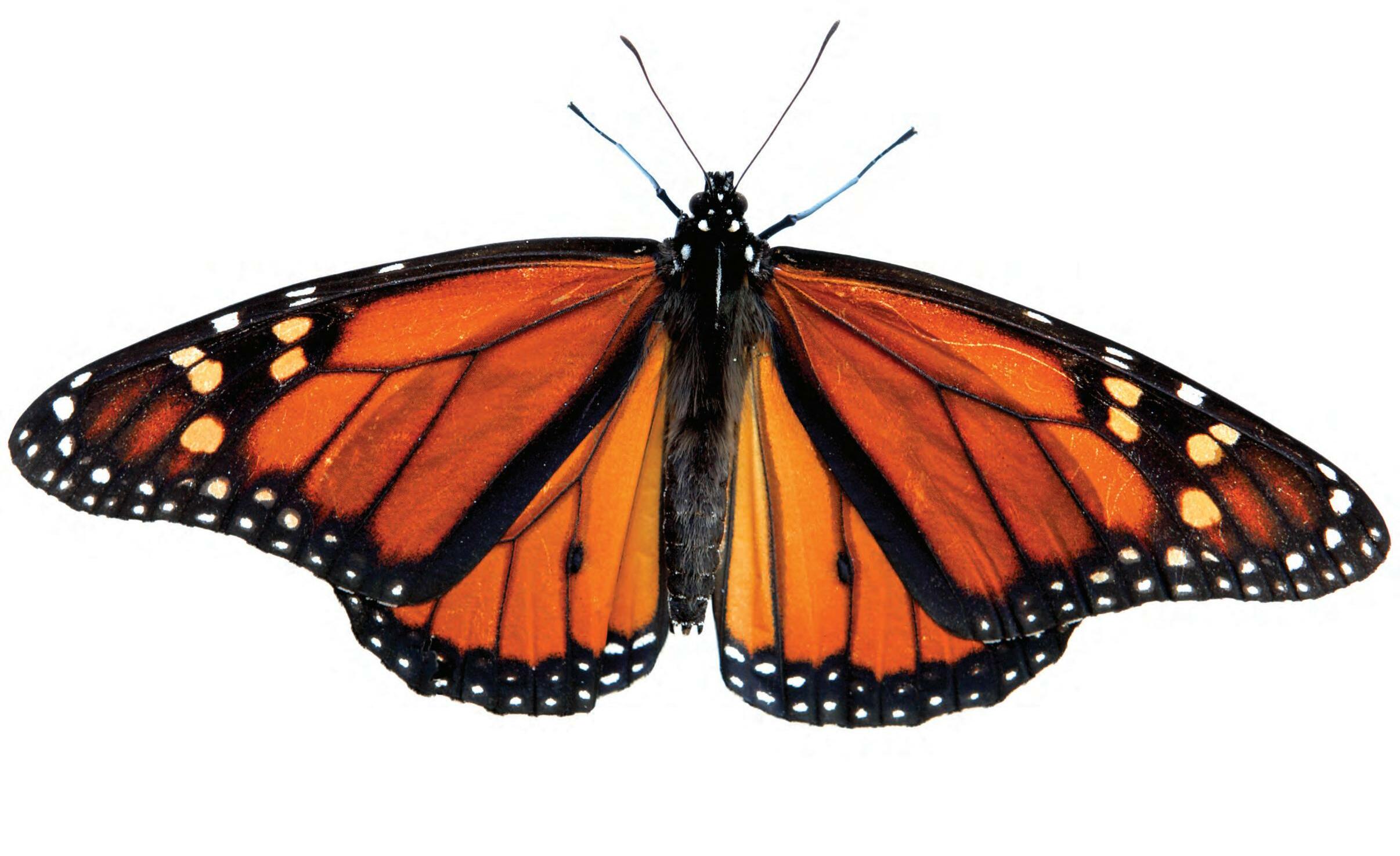
subjeCTs: Humanities and Science grade level: Sixth TeaChers: Pat Kidder and Amy Kreuzburg P’14,’17 habiTs of learning: Coexistence, Critical Thinking, Communication, Creativity
In a simulated study, Cardigan Mountain School receives recommendations from five different companies for butterfly habitats on campus. Sixth graders are first tasked with understanding the needs of the Monarch butterfly––life cycle, food sources (throughout life), predators and environmental dangers, and habitat requirements. Then, in groups, students assess the companies’ proposals, developing maps of the proposed sites. Finally, each group creates a slideshow to present their findings to Cardigan administrators.
“In addition to learning about Monarchs and developing their mapping skills,” explains Ms. Kidder, “the students practice interpersonal skills––communicating with the other members of their team, setting team goals, understanding each other's strengths in order to assign reasonable tasks and deadlines, scheduling meetings outside of class, and creating a visual and verbal presentation together.”
e Academic Toolbox: An Ideal Learning Environment

subjeCT: peaks™ grade level: Seventh TeaCher: Jarrod Caprow habiTs of learning: Self-Awareness, Ownership, Creativity
This assignment requires students to think critically about the ways in which they learn best. After reflecting on all of the classroom environments to which they have been exposed, they are asked to create an illustration of their ideal classroom-learning environment. They need to consider how the classroom is arranged, what technology and resources are available, and what other features are needed to make it an ideal space in which to learn.
“While we can’t always provide students with their ideal learning environment at all times, it’s important for students to understand how they learn best and what they need to be successful here at Cardigan, and more importantly, at their next school,” says Mr. Caprow.
24
Slap
subjeCT: Performing Arts grade level: Eighth and Ninth TeaCher: Jeff Good habiTs of learning: Growth Mindset, Self-Awareness, Communication, Ownership, and Creativity
“I find that our boys are less intimidated by the physical nature of theater (movement) than the vocal nature of the art (song and dialogue),” says theater teacher Mr. Good, “so one of the foundational elements of my theater arts courses is learning a physical routine invented by the Russian director Svelod Meyerhold.” Meyerhold took ordinary physical actions such as “the slap” or “throwing a stone” and broke them down into 20 or so moves. Mr. Good’s students start by learning the moves in the correct order, looking for patterns, and then using their imagination to form images and narratives to assist in achieving muscle memory; then they begin to assess their execution of the moves in terms of performance skills such as expressiveness, precision, and rhythm.

“We video their routines three times during the term,” Mr. Good continues, “and the boys become more self-aware of their performances each time. By the end of the term, they begin to concentrate on perfecting small details of specific moves and are acutely aware when a performance, either theirs or one of their peers, nails it.”
Goodreads Capstone Project
subjeCT: English grade level: Ninth TeaCher: Marten Wennik P’15,’16 habiTs of learning: Self-Awareness,
Critical Thinking, Communication, Ownership
Each year, Mr. Wennik chooses a theme for his ninth-grade English class; last year it was “American Beauty,” how Americans view themselves and how others around the world view Americans. In the fall, students began by reading short essays; in the winter they read several novels: Montana 1948 by Larry Watson, The Reluctant Fundamentalist by Mohsin Hamid, The Mothers by Brit Bennett, and The Loved One by Evelyn Waugh. In the spring, for their capstone projects, students got to select a book of their own, read it independently, and then teach the book to their classmates, leading a discussion on its connection to the class theme.
Throughout the year-long intellectual journey, students reflect on what they are reading at goodreads.com, an online community for readers. On average students submit nine Goodreads reflections per book, as well as a final book review, which adds up to a lot of reading and writing over the course of the year.
“The reflections can’t just be plot summaries but require students to write about their emotional and intellectual responses to what they are reading,” says Mr. Wennik. “Furthermore, they directly influence what we discuss in class and also give them a chance to think about their online presence and how to build a positive digital identity.”
25
e
Building Rockets: Testing the Laws of Physics
subjeCT: Science grade level: Eighth TeaCher: Rory Germain habiTs of learning: Coexistence, Critical Thinking, Communication
In this project, students build and launch pneumatic rockets. They begin with a research phase in which they explore the different design choices they can make in the construction of their rockets, ultimately narrowing their focus to one independent variable that they will manipulate to impact the dependent variable—the distance traveled by the rockets. Working in groups, the students set team goals, using each other's strengths to assign reasonable tasks and deadlines and schedule meetings outside of class. Students are expected to apply content knowledge from previous units on acceleration, Newton's Laws, and the other laws of physics. In the final phase, students launch their rockets across Marrion Field, collecting data and explaining their results in lab reports.

Business Letters and the Decorating of a Classroom
subjeCT: English grade level: Eighth TeaCher: Alex Gray H’14, P’14,’16 habiTs of learning: Communication, Creativity
When Mr. Gray’s eighth-grade students enter his classroom on the first day of classes, they encounter bare, cementblock walls, painted an uninspiring shade of off-white. Their first assignment is to acquire decorations. The only hitch is that students must write to companies and receive the decorations for free.
“Students learn about the specific and formal writing style of a business letter as well as how to write persuasively so that the person receiving the letter is compelled to respond,” explains Mr. Gray.
Over the years, students have written to The Pope, professional sports teams, athletic equipment manufacturers, colleges, auto and cycling companies, fashion designers and retail companies, the NH State Police, and the U.S. Marine Corps. In return they have received dirt from Fenway Park, a warm up suit from the LA Lakers, hockey sticks used during professional games, signed posters and flags, hockey pucks, and hot dogs. Acceptance as well as rejection letters are also posted on the walls.
26
Field Research: Understanding Cardigan’s Forest Biome
subjeCT: Science grade level: Sixth
TeaChers: Pat Kidder and Amy Kreuzburg P’14,’17
habiTs of learning: Growth Mindset, Critical Thinking, Creativity
In the fall students learn about the habitats of various animals and explore the woods around the Cardigan campus. Practicing their observation skills, they look for tracks, scat, and any other evidence of the creatures that inhabit The Point. Then, with the help
of a motion-activated camera, students confirm their observations with footage of the animals they are studying. Last year, with the help of bait—sliced apples, chunks of pumpkin, and eventually the carcass of a beaver—students captured footage of squirrels, deer, rabbits, and a lone weasel. The project continued through the winter and spring, and the boys recorded where different animals were found around campus on a map. While building their understanding of the biological needs of living beings, students also learn to see themselves as scientists, asking questions about the world around them and seeking answers through scientific research, both written and experiential.

27
Murder and a Meal Mystery Lab
subjeCT: Science grade level: Ninth TeaChers: Melissa Escalante P’20,’22 and Meredith Frost P’25 habiTs of learning: Coexistence, Critical Thinking, Communication
This laboratory investigation involves several phases, the first of which focuses on developing students’ knowledge of biochemistry and nutrition and how to use indicator testing in the laboratory to analyze food for the presence, or absence, of biomolecules. Their first lab is the "Junkfood Jamboree" in which students test common snack items for the presence of important macromolecules––carbohydrates, lipids, proteins, and nucleic acids. Next, they test the stomach contents of a mock murder victim, using forensic science to determine the location of the victim’s last meal. Analysis of data and applied research is a major milestone in this project, requiring the use of strong critical thinking as they solve the mock murder mystery.

Grappling with the Impact of Plastics


subjeCTs: English, History, peaks, Science grade level: Eighth TeaChers: Cheryl Borek P’10,’12,’15, Austin Cabot, Doug Clark, and Chris Kenny habiTs of learning: Coexistence, Critical Thinking, Communication
In this multi-disciplinary project, students learn the geopolitical, chemical, and environmental impact of plastics. They first face questions about how their own bodies may be adversely affected by the chemistry of plastics, and then they also grapple with the historical, economic, social, and political ramifications of the plastics industry. The project begins with research on the synthetic chemicals found in plastics, providing students with the basic knowledge from which they can evaluate the effects of petrochemicals and create persuasive presentations in collaboration with their peers. Divided into groups, the boys take on the personas of fictional characters who live in the town of Plasticville—an unemployed worker, for example, or a surfer who is an environmental activist—and then present their case, pro or con, to the “city council” that is seeking to ban single-use plastic bags. Part of their grade is dressing the part, so during the day of the town meeting, activist surfers and Dow chemical execs can be found walking around campus.
28
sTudenT posTers offering Two perspeCTives on The impaCT of plasTiC
All Are Welcome
subjeCT: Visual Arts grade level: Eighth TeaCher: Nina Silitch P’19,’21 habiTs of learning: Growth Mindset, Self-Awareness, Coexistence, Critical Thinking, Communication, Creativity
In this art project students consider what makes them feel welcome and the ways in which they can make sure others feel welcome. Students learn about the work of artists Suzanne Kaufman, Carmen Lomas Garza, Kadir Nelson, Stephanie Boutari, Adrienne Gelardi, Karen Anderson Singer, and K.R. Santhana Krishnan. Then the students create their own works of art, keeping in mind the eight Artist Habits of Mind: Develop Craft, Engage and Persist, Envision, Express, Observe, Reflect, Stretch and Explore, and Understand the Art World. When their projects are complete, students compose artist statements that consider the skills they are developing, the challenges they had to overcome during the creative process, the connections they hope to make with their viewers, and the areas they want to explore next.
eVery tIme I walk In the door, there Is always someone InsIde who always gIVes a warm welcome wIth much taIl bangIng and body waggIng. when lookIng at my work I am tryIng to conVey that If you are eVer worrIed, there’s always goIng to be a dog or any other pet out there who any tIme they see you wIll be full of joy. I wanted to paInt my dog because he Is what I thInk of when I hear the word welcome.

– amanuel leVIne ’23
Making of a Monologue: Illuminating an Idea, a Fictional Character, or a Real Person
subjeCT: Humanities and peaks grade level: Seventh TeaChers: Jarrod Caprow, Meg Lloyd, and Rich MacDonald P’18 habiTs of learning: Critical Thinking, Communication, Creativity
In this end-of-year assignment, students reflect back on all the characters––historical and fictional––they have met and the ideas they have encountered throughout the year. Guided by open-ended questions of their own creation, students then choose one character or idea to research in more depth and develop a main message that they want to convey in a monologue. Before writing their scripts, students practice “being” their characters during an open mic performance, experimenting with their costumes and mannerisms to determine how best to portray their characters. As a culmination for the project, students dress in character and present their monologues to their classmates.
29
e
Math of the Hunga Tonga Volcano
subject: Math grade level: Eighth and Ninth teacher: Morgan Wilkinson habits of learning: Growth Mindset, Critical Thinking, Creativity
“Nobody is born knowing math,” says math teacher Morgan Wilkinson. “It is something everyone has to learn, like walking or talking.” For Mr. Wilkinson that means not only teaching mathematical skills but incorporating lots of practice on number sense and creative thinking. Take for example, the connections he made between math and the eruption of the Hunga Tonga Volcano in December 2021.
“We watched a news report, read an article, and then discussed relevant mathematics concepts,” he says. “My Algebra I students discussed how to measure sound waves to predict how long they will take to reach various points around the earth (distance = rate * time), while my Algebra II students made connections between the Richter scale and their knowledge of the logarithmic scale; and my Pre-Calculus students talked about the resulting tsunamis and how accurately predicting and measuring them (using trigonometric wave functions) can help officials give advanced notice to seaside communities around the world.”
Manifest Destiny on Trial

subjects: Humanities and PEAKS grade: Seventh teachers: Jarrod Caprow, Meg Lloyd, and Rich MacDonald P’18 habits of learning: Coexistence, Critical Thinking, Communication, Creativity
When the U.S. assistant to the associate undersecretary for historical perspective learns of the seventh grade’s research into Manifest Destiny, he writes to ask that they put Ms. Destiny on trial and determine whether she is good or bad. Students are assigned roles from historical figures—Andrew Jackson, Thomas Jefferson, Ralph Waldo Emerson—to common citizens—a white female Quaker from Pennsylvania, an indigenous member of the Blackfoot tribe, an environmental scientist from the Svalbard Global Seed Vault—to members of the press. Prior to the trial, students conduct research and write persuasive essays that accurately reflect the varied perspectives of the people they represent, as well as present clear, convincing, and compelling arguments in support of or in opposition to Manifest Destiny. During the trial, witnesses are called before a committee for questioning, and then the committee determines whether Manifest Destiny’s legacy is good or bad.
“Every year the verdict is different!” says humanities teacher Mr. MacDonald. “Because the boys are playing characters, how Manifest Destiny fairs depends on who is arguing in her defense. Having said that, I’ve been doing this unit for years and years, and the boys don’t usually remember the verdict; they just remember how much fun they had and are grateful for the practice researching.”
30
e Great Paper Airplane
subject: Math grade level: Variable teacher: Kyla Joslin habits of learning: Critical Thinking, Communication
Students begin this unit by learning how to collect statistical data, starting with the formation of a question that results in variable answers. For example, “How old am I?” is not a statistical question, but “What are the ages of the students in the classroom?” is.
Then the fun begins: developing a paper airplane and creating three different prototypes out of three different weights of paper. Students then take their research outside, measuring their airplanes’ horizontal flights. With the resulting data, students learn about mean, median, and mode and develop different kinds of graphs including box plots, histograms, line plots, dot plots, and scatter plots.

Macbeth Today
subject: English grade level: Ninth teacher: Nicholas Nowak habits of learning: Critical Thinking, Communication, Creativity
After listening to Shakespeare’s Macbeth and completing close readings for each act, students are asked to select one of the following prompts:
r gender roles: How do values of manhood differ in modern times? What do you think it takes to be a good man? Explain how your views are like or unlike those in the play. Use examples from the text.
r ambition: What is Shakespeare trying to say about leadership? Who do you think the best leader in the play was? What qualities make that character a successful leader? Use examples from the text.

r same old story: Compare Macbeth to another historical figure or series of events. Using evidence from the text, prove that history repeats itself by showing the similarities in the storylines.
Students are instructed to use convincing evidence from the text and real life to compose a persuasive essay, remembering that part of persuasion is not just what you say but how you say it. To that end, students learn to use advanced figures of speech to create purposeful syntax with style.
31
on the point
e Charles C. Gates Invention & Innovation
Competition: Learning to Follow Creative Instincts
It’s just before 9:00 a.m. on the Friday of Spring Family Weekend. Outside Wallach, sixth and seventh graders mill about in white lab coats and khaki pants. Official name tags are pinned to the pockets of their coats and green Cardigan ties hang from their necks with crisp knots pulled tightly up to the collars of their white button-down shirts.
Director of Gates Eric Escalante P’19,’22 and Gates coach Annie Clark herd them together, lining them up and directing them to face the camera. For just a moment the boys turn and smile together, marking an important moment for all of them— the completion of their inventions for the 2022 Charles C. Gates

Invention & Innovation Competition.
But lest you think it’s all polish and perfection, it’s important to note that just after this moment, one of the boys leans a little too far forward. His sunglasses—mirrored, the very definition of coolness—slide off the end of his nose, directly into the storm drain at his feet. All eyes break from the camera and turn to stare into the storm drain.
As the boys make their way back into Wallach, some speculate about the ways they might be able to retrieve the glasses, but for the most part, they have already moved on, thinking instead about the hours ahead during which they will share their inventions with the community.
The boys have been working toward this moment for five months—researching their ideas, developing prototypes, and refining their marketing plans. As the first members of the community enter Wallach, the boys take their places next to their posters and recite their elevator pitches to themselves one last time. For Mr. Escalante and Ms. Clark, it’s a proud moment; they’ve encouraged and problem-solved and coached and led these boys forward since January, and now it’s time for them to step back and let the boys take center stage.
Wallach comes alive with voices. In the Gates i.D.e.A.Shop, judge Dan
32on the point
DeMarsP’11,’18 listens to two eager inventors, James Frost’25 and Brady Drury ’25, explain their Dry Cam, an attachment for a camera tripod that holds an umbrella for rainy-day photoshoots. In the e.p.i.C. Center, inventor Romeo N’kumbu ’24 discusses his Cookie Launcher with a group of parents, explaining that it not only works for humans but for pets as well. And upstairs in the Tsui Yee Gallery, Finn Donelan ’24 demonstrates The Turtle Getaway, a floating platform developed for the turtles in Cardigan’s Living Lab.

It’s a delight to overhear short bits of conversation. Take Wilson Yu ’25, for example. He’s presenting the MagShirt, a product meant for people with arm or shoulder injuries; magnets replace one of the shirt’s side seams, making dressing and undressing easier. For one parent who works with orthopedic patients, the invention offers a solution to her patients’ troubles; her enthusiasm for Wilson’s shirt is infectious. Then there’s the conversation between Noah Humphrey ’24 and Director of Communications Chris Adams, who used to work in marketing in the ski industry. Noah’s invention is a ski goggle strap that uses snaps instead of buckles for easier adjustment on the fly. Mr. Adams quickly takes out his phone and snaps a picture of the prototype to share with his former colleagues. From a folding yardstick to a device for preventing slamming doors, from a skateboard with interchangeable wheels to a defogging device for face masks, the boys followed a variety of problems to their logical conclusions, developing practical and most often very simple solutions.

33
at top: Director of Gates Eric Escalante with Watts Ooten ’24 and Marcelo Galen ’24, discussing their design of the Tenni Mark, a device used to brand tennis balls so they can be distinguished from those belonging to others on a multi-court enclosure; above: Seventh graders Annabi Diallo and Channing Rice working on a prototype of their folding yardstick
awards
r
r
r
r
r
r
r
r
r
For two hours the boys shared their inventions with the community—faculty, parents, students, and friends. But the most important guests were the judges— Alyssa Boehm, Mr. DeMars, Timothy Frazier ’00, and Peter Goehrig. With a

total of 36 inventions and 54 inventors, the judges had a lot to learn, and by the end of the morning, they had chosen seven teams with whom they wanted to have further discussions.
Late that afternoon, the teams presented their inventions to a live audience in Humann Theatre and answered the judges’ questions. The boys not only brought their posters and prototypes but also their bravery and confidence; they stood at the front of the theater selling their ideas with solid market research and fully developed prototypes.
Then came the waiting. The inventors, the community, the world had to wait until the next morning for the results of the competition. When the awards were announced, there was plenty to celebrate.
Helmeteer inventors Emilio Rojas ’24 and Guillermo Zaragoza ’24 came out on top, and two inventions—Key Point by Terry Langetieg ’24 and Jeongung “Edgar” Choi’24 and The Shampoo Locker by Junyan “Joey” Huang ’24 and Zhengyuan “Charlie” Liu ’24—received patent nods, a special designation that provides financial support for pursuing a U.S. patent.
And last but not least, Romeo N’kumbu, who developed the Cookie Launcher, didn’t make the finals, but he left an impression on the judges. They decided to award him with an unofficial prize, the Judges’ Whimsical Award, due to his commitment to following his passion and love for Oreos.
All the boys, regardless of the awards, spent five months growing their inventions, from vague ideas and half-formed questions into viable solutions and tested prototypes. They learned to follow their creative instincts, persevere through dead ends, practice and polish their presentation skills, and speak with confidence about their original ideas. It’s what being in sixth and seventh grade at Cardigan is all about. And who knows, perhaps these same skills might just help them figure out how to get those sunglasses back. r
3 4 o n t h e p o in t
above: Head of School Chris Day listening to a sales pitch from sixth graders Cole Brown and Tigger Tanglertsumphun, who developed the Snow Bro, a braking system that attaches to a standard snow scooter
third place: Easy Strap by Noah Humphrey ’24
Second place: Shoelace Lock by Leo Krawitt ’25
FirSt place: Helmeteer by Emilio Rojas ’24 and Guillermo Zaragoza ’24
BeSt SaleSmen: Helmeteer by Emilio Rojas ’24 and Guillermo Zaragoza ’24
BeSt preSentation: Dry Cam by James Frost ’25 and Brady Drury ’25
community choice award: In ‘n’ Out Cleats by Leo Kim ’24 and Julian Santini ’24
JudgeS’ whimSical award: The Cookie Launcher by Romeo N’kumbu ’24
patent nod: Key Point by Terry Langetieg ’24 and Jeongung “Edgar” Choi ’24
patent nod: The Shampoo Locker by Junyan “Joey” Huang ’24 and Zhengyuan “Charlie” Liu ’24



3 5
clockwise from the top: Gates judge Dan DeMars learning about the Dry Cam, an invention developed by sixth graders Brady Drury and James Frost; Federico Laresgoiti ’25 developing a stake to secure his invention, On Mark, an attachment for soccer goals that helps athletes to practice shooting goals into the corners and away from the goalie. Rio Burnett ’25 was also on this team; Gates judges Peter Geohrig, Timothy Frazier ’00, Dan DeMars, and Alyssa Boehm with Joe Cougar in front of Wallach prior to the 14th Annual Gates Competition
Cardigan Boys of Color Define eir Own Path
Don’t follow the path. Go where there is no path and begin the trail. When you start the new trail, equipped with courage, strength and conviction, the only thing that can stop you is you.
— Ruby Bridges, American Civil Rights Activist
As an opening to Black History Month in February, the Cardigan Boys of Color (CBoC) spoke in Chapel, sharing their knowledge and genuine desire to educate the community. With no defined path before them, these boys are leading, as Ruby Bridges suggests, with courage, strength, and conviction.

Blake Hodges ’22 and Grady Allison ’22 began the chapel service by debunking myths about Martin Luther King, Jr. based on an episode from First Name Basis, a podcast by Jasmine Bradshaw. Take for example the myth that MLK would have been against riots. Blake and Grady
explained that Dr. King believed riots were the language of the unheard. While many at the time claimed that riots proved that black people hated white people, Dr. King saw it differently:
“This bloodlust interpretation ignores one of the most striking features of the city riots. Violent they certainly were. But the violence, to a startling degree, was focused against property rather than against people. There were very few cases of injury to persons, and the vast majority of the rioters were not involved at all in attacking people…Why were they so violent with property then? Because property represents the
white power structure, which they were attacking and trying to destroy.”
“We wanted to present information that hasn’t been widely shared before,” says Carter Davis ’22, who along with Dom Taylor ’22, shared the story of Ruby Bridges during the chapel service. “There’s more than just MLK’s ‘I Have a Dream’ speech.”
“We wanted to show how much the world has changed, but also how long it’s taken,” added Student Leader Preston Merrick ’22, who chose to talk about Nicholas Johnson, Princeton University’s first Black valedictorian in 2020. “I also chose Johnson because I wanted to speak
36on the point
Members of the Cardigan Boys of Color with Dr. Keith Hinderlie, owner of Hinderlie and Associates, LLC. Dr. Hinderlie has presented workshops across the country on diversity, inclusion, multicultural competence, and the social/emotional experiences of children and was on campus to help Cardigan with a diversity, equity, and inclusion climate assessment, part of phase 1 of Cardigan Mountain School’s Strategic Plan for 2032 (photograph courtesy of Keith Hinderlie).
noyes academy Canaan, NH has seen its share of educational institutions come and go. After Cardigan’s move to The Point, the Lodge (Cardigan’s original academic and residential facility) provided a home for the College of Advanced Science, and later for Canaan College. Well before Cardigan’s founding, however, the School’s Ovilla House was a stop on the Underground Railroad and also provided housing to students at Noyes Academy. That school had opened its doors in March 1835, with 28 white students, 14 black students, and a mission to assure that education was accessible to students of all races. Unfortunately, the school did not last long; in a dark moment in New Hampshire history, an angry anti-abolitionist mob destroyed Noyes Academy the following summer. Students were given only hours to leave town, with several traveling directly to the Oneida Institute, near Utica, NY. As a historical marker near today’s Cardigan campus points out, the terrible event had a silver lining: it spurred many to focus their life’s work on social justice. Next to the historical marker stands a replica of Noyes Academy, rebuilt in 1839 to house Canaan Union Academy, a whites-only school that operated until 1892. In 1903 the Town of Canaan converted the old school building into a library, and later, when the library was moved to a larger community building, the Canaan Historical Society and Museum took over responsibility for the building. r

about someone who shot for the stars and succeeded,” continued Preston.

For these boys, seeking understanding about race and racism and sharing what they have learned with their peers wasn’t limited to one chapel service. As members of CBoC, a group founded in 2021 by Gabe Quinn ’21, the boys met regularly this past year to engage in conversations and seek the support of their peers. Prior to each meeting, Dom Taylor, who was the CBoC student leader, chose a topic and sent out readings and links for the boys to explore. While the winter schedule made it more difficult for them to meet, during the fall and spring, the group gathered weekly after dinner to discuss current and historical events—from the impact of the Confederate flag to slavery and the justice
system. In 2021, they even had the opportunity to speak with Ruby Bridges during a virtual meeting.
“Before that meeting, I didn’t really even know who she was,” reflects Dom. “Ever since, I think about her and remember she is the reason why I’m here. At the time, she didn’t know the impact she would have; she must have had so much determination to go to school without any friends. Her independence is really powerful and inspiring.”
It is worth noting that the boys in CBoC have chosen to make their group all-inclusive, inviting anyone in the community to join in their conversation. “It’s been great to share what I think and hear what my peers think,” says Preston. “I’m proud to be part
of the discussions and feel like they have the power to change perspectives.”
Treva Murphy ’22, who is white and also a member of CBoC, agrees. “Some of the topics we talk about are really hard but we can’t ignore them,” he says. “CBoChas allowed me to connect with students of color, hear what they’ve gone through, and build friendships with them.”
What’s next for the group? Unanimously, the boys hope to grow. They want everyone on campus to be involved in CBoC; they are excited to share their knowledge and listen to the perspectives of their peers. Their optimism is contagious, and if they can hold onto it as they prepare for their journeys beyond Cardigan, they are just the sorts of leaders this divided world needs. r
37

38on the point
Cardigan Partners with Dartmouth College on Fellowship for Aspiring Educators
For Associate Head of School and Dean of Faculty Josh LeRoy P’23,’26, spring at Cardigan is
hiring season. Looking to fill vacant positions, he has a lot to consider, including what each candidate will contribute to a community that is increasingly seeking diverse perspectives. A pilot partnership with Dartmouth is helping with his recruitment efforts.
“Our faculty need to reflect what our kids see beyond our campus,” says Mr. LeRoy. “I can convey trust to our students, but in order for our students to have the best experience here, to have the best opportunity to grow and learn, they need to be able to have conversations with adults who have similar backgrounds and outlooks as they do. For our students and for our community, we have to be ready as a school to recruit and retain any type of faculty, no matter their religion, race, gender, sexual orientation, culture, or citizenship.”
Mr. LeRoy is not alone in his thinking. In fact, as Cardigan developed action areas for The Strategic Plan for Cardigan 2032, diversity, equity, and inclusion took center stage: “In all areas of school life, Cardigan will seek to understand our strengths and weaknesses around issues of diversity, equity, and inclusion. Using this as a platform, the School will construct and implement intentional programming and curricula that provides for self and community reflection, and an introduction to and celebration of others and otherness, transforming awareness into hope, empowerment, and action.”
The strategic plan also calls for “seeking new opportunities for attracting diverse faculty, staff, and board members, and reviewing, constructing, and implementing policies that support their success at Cardigan.” This means changing the School’s hiring processes and expanding recruitment tools to include additional agencies and a wider range of referrals.
Cardigan has also committed to a partnership with Dartmouth College. The goal of the project, called the Dartmouth Fellowship for Aspiring Educators, is to recruit promising candidates from underrepresented populations and help them prepare for successful high school teaching careers.
Accepted fellows will commit to enrolling in Dartmouth’s 10week master’s program for three consecutive summers and to working at Cardigan for two years, either teaching or working in
advancement, admission, college counseling, or DEIdevelopment. Cardigan will pay a base salary with benefits, provide room and board, and cover half the fellow’s tuition. Dartmouth will cover the other half of tuition and provide access to the Dartmouth Center for the Advancement of Learning, which helps faculty members develop teaching tools and strategies.
Cardigan is not the only independent school involved in this project. The Lakes Region Consortium—including Dublin School, Holderness School, Kents Hill School, Kimball Union Academy, New Hampton School, Proctor Academy, and Vermont Academy—have all committed to the partnership as well. “As the head of school at Cardigan I’m so pleased, and as a graduate of the MALS program I’m so proud that Cardigan is able to partner with Dartmouth and other Lakes Region boarding schools in this incredible opportunity," says Head of School Christopher Day P’12,’13.
Dublin School Head Brad Bates, who helped spearhead the Dartmouth partnership, says the Lakes Region fellowships will help diversify faculty in a way that strengthens the entire school community: “It will be transformative, with talented people coming to our schools and bringing their own perspectives from a variety of backgrounds. It’s getting all of us to think differently about the student experience, especially for an underrepresented population that is, happily for us, growing.”
While Cardigan does not currently have any faculty involved in the program, Mr. LeRoy is working closely with Dartmouth to enroll a candidate by next summer. “There are a lot of good candidates out there,” he says. “If we’re going to make change, we have to start now.” r
39
Becoming an Insider: Writing Cardigan’s History
By JuDith SoLBerg
As part of Cardigan’s 75th Anniversary celebrations, the School entrusted Director of Archives and Special Projects Judith Solberg first with cataloging and organizing Cardigan’s extensive historical documents, and then with collating them into a comprehensive story of how the School community has developed since its founding. The Cardigan Archives now provides a permanent home for the School’s institutional history, and a third edition of the Cardigan Mountain School history went to press this summer. The image-rich coffee table book will be available following Cardigan’s 75th Anniversary celebration in October. This excerpt from the book’s preface offers a behind-thescenes glimpse at Ms. Solberg’s process from the past several years.
There is value in having an outsider’s perspective, and also in being swept into Cardigan’s story: the two viewpoints simply lead to different observations. –
The history of Cardigan Mountain School has already been documented by two very capable and knowledgeable authors. Bob Hopkins, who wrote the 1960 edition, was a founder, incorporator, and trustee of the School, serving from 1945 until his death in 1962. Dick Rearick, the author of the 1995 edition, was Cardigan’s business manager in the late 1970s and returned a few decades later as the School’s director of development. Both of these men brought an insider’s perspective to their writing; they knew the leaders of the School well, and their own work had influenced the course of the School’s history.
When Head of School Christopher Day P’12,’13 and Cardigan’s Board of Trustees asked me to write the third edition, I was most definitely not an expert on Cardigan. While I had worked in independent schools for decades, and I had written other school histories, I had never set foot on The Point. I was a tabula rasa. Being an outsider is both intimidating and freeing: all interviews bring new perspectives, all archival finds catch the attention, and you can ask any question—the most basic of questions—without losing credibility. You can structure your book with the cold rationality of a project manager. You have
the discipline to spend so-much-timeand-no-more researching one topic before moving on to the next.
For better or worse, however, that neutrality disappears quickly. My first step toward writing this new edition of Cardigan’s history was to establish the Cardigan Archives, and as I processed materials into the collection, I began to feel affection for certain class years and longgone faculty members, and to become nostalgic about the demise of this or that activity or tradition. I have to admit: I began to form opinions. I must also acknowledge that, once I spent an academic year on the campus close to students and the rhythm of school life, working with exceptional new colleagues (and with a husband working in the School’s administration), I was carried along into the School’s history myself.
There is value in having an outsider’s perspective, and also in being swept into Cardigan’s story: the two viewpoints simply lead to different observations. For this edition of the history, I used research methods that I hoped would preserve the best of both perspectives. First, I avoided using interviews to build my initial understanding (although at different points I did interview Cardigan’s past heads of school,
40on the point
and they were universally generous and helpful with their insights). Instead, I relied almost exclusively on contemporary primary source material. Setting aside the Summer Session history, which merits its own research project, I slowly assembled archival material—trustee and corporation minutes, school publications, correspondence, films, photographs, and more—into a mosaic of the past, which became more detailed and nuanced with each added item. I then wrestled the mosaic into narrative form, hoping to provide readers with an insider’s perspective and give voice to those who had lived through the events.
I also structured the book in two halves, developing both an historical viewbook and a chronological narrative. The viewbook portion introduces the reader to life at Cardigan in the present day, offering historical context for current programs and traditions. In essence, it is a visual representation of the Cardigan Way, and a



crash course in what it means to be a part of this vital, vibrant school community. Familiar themes rub shoulders with lesserknown historical facts, making this an accessible and fun introduction to all things Cardigan.

The narrative portion of the book builds on the work of both Hopkins and Rearick, but extends to include the years from 1995 to the present day. This section risked becoming “insider baseball,” in that it delves into the details of institutional challenges, strategies, and decisions that have shaped the course of the School for more than 75 years. Over this narrative, however, I have layered a montage of photographs and documents sourced from the Cardigan Archives. These images represent a campus-centered perspective that runs in parallel with the strategic work of the administration. Interested readers can learn how the sausage is made, while


glimpsing the daily life of students and faculty during each era.
I suspect it would be difficult for anyone to remain an outsider for long at Cardigan Mountain School; it has always been a warm, welcoming community. Cardigan’s Board of Trustees and Chris Day took a leap of faith in entrusting me with this project, and they welcomed me with open arms. It has been my privilege to dive deep into the School’s history, spending several years getting to know the people and programs (past and present). While sharing Cardigan’s story is a serious responsibility, I hope that this book communicates some of the joy that is always present on The Point. r
Cardigan Mountain School at Seventy-Five
41
above: Cardigan Mountain School’s history has been well-documented in two books—once in 1960 and again in 1995. Now celebrating its 75th year on The Point, the School has once again reflected on its past and how that past has influenced the School’s present and future. Judith Solberg is the author of the most recent edition.
from marrion field
Athletic Master Plan Addresses Challenges to Program Growth
Cardigan has a proud history of outstanding athletic performance. What will that look like in 2032?
It’s quite literally a gamechanger for Cardigan.
– ryan frost p’25, – director of athletics – and head lacrosse coach –
Every March, as the boys return from spring break, Director of Athletics and Head Lacrosse Coach Ryan Frost P’25 is more often on the phone than the field. He’s busy calling our peer schools and other facilities in the area looking for practice space for Cardigan’s spring teams because our home fields are still too wet from melting snow. Even when he is successful in securing space, the outcome is less than ideal: our players and coaches often spend more time riding to and from practice than they do actually practicing.
To address this and other challenges to the growth of the Cardigan athletic program, the School formally engaged in a process to evaluate all current athletic facilities and identify options for improvement. A team was formed that included several members of the faculty, administration, athletic leadership, and two outside firms—Stantec, a leading sports facility consulting firm from Boston, and Pathways Engineering, Cardigan’s longtime civil engineering partner from Lebanon, New Hampshire.
Over the course of several meetings during the winter of 2019-20, the team reviewed the School’s existing program, identified facility constraints, noted needs and desires, and determined a list of priorities. The result is known as the Athletic
Master Plan and is included in The Strategic Plan for Cardigan 2032 under Action Area Three: Program and Curriculum. Cardigan’s Board of Trustees approved the new strategic plan in January 2022.
Construction has already begun on two priorities listed in the plan. The Snow and Bike Center, located down the hill from Wallach, will provide proper storage, locker, video analysis, and equipment tuning spaces for Cardigan’s growing snow sports and mountain bike teams.
“I am proud of the growth our program has achieved,” reports Director of Alpine Skiing Julia Ford. “This new facility, and the dedicated spaces for equipment tuning and video analysis, should help the team’s results continue to improve.”
New Director of Mountain Biking Doug Clark agrees: “With the Snow and Bike Center coming online this year, I couldn’t be more excited to see our programs grow. I also can’t thank the Development Team and donors enough for prioritizing this project at such a pivotal time for both programs.”
On the other side of campus, in the formerly vacant field near the intersection of Back Bay Road and Prospect Hill Road, and adjacent to the Williams Fields, crews were busy all summer installing the School’s new artificial turf field. This
42From marrion Field
increases the number of soccer and lacrosse fields on campus, but more importantly it permits practice and play much earlier in the spring season, meaning Coach Frost can spend more time coaching and less time on the phone. The field also has lights, providing much needed outdoor space for activities of all kinds during the spring.
“It’s quite literally a game changer for Cardigan,” says Coach Frost. “For so many years, our spring teams have done the best they can—practicing indoors, out in the parking lot, or driving to other turf fields. Now we’ll be able to get our work done at home, and our boys will be able to spend more time engaged on campus and not on the bus.”
A dedication of the turf field is planned for prior to the varsity soccer game on October 22, as part of Fall Family Weekend and Cardigan’s 75th Anniversary Celebration. The field will be named in honor of Cardigan founder James C.


43
Campbell, who believed in opening the door of opportunity for others. r
above: Artist’s rendering Campbell Field; at right: The new Snow and Bike Center
Simon Manners Enjoys Break Out Ski Season
Participation and Results Continue to Grow for Cardigan Ski Program

Under the watchful eye of Director of Alpine Skiing and former Olympian Julia Ford, Cardigan’s Alpine Ski Team continues to grow, both in terms of participation and results. This past season saw 33 Cardigan skiers push out of the starting gate in both US Ski & Snowboard and New England Prep School Athletic Association (nepSAC) competitions.
One young Cougar, Simon Manners’25, led the Cardigan U12 team with consistently strong skiing and an impressive string of consecutive podium finishes (finishing in the top three). Competing in the U12 age division of the New Hampshire Alpine Racing Association (nhArA), Simon finished first in Western Division standings, earning him a good starting number for the nhArAU12 State
Championships held in March at the Mittersill Alpine Resort in Franconia, New Hampshire. Simon skied strongly on the first day of the event, finishing second in the slalom. He was able to back up that result with more fast skiing in the next day’s giant slalom, also finishing second.
The following week saw the region’s best U12 ski racers gather at Gunstock Mountain Resort in Gilford, New Hampshire for the Francis Piche Invitational—a traditional rite of passage for the best young skiers in the Eastern United States. Skiing against boys from nine different states, Simon improved his results from the previous week, winning the slalom on Saturday before taking third place in the giant slalom on Sunday. Congratulations, Simon! r
Cardigan Student Competes in Caribbean Championship
Three Swimmers from Jamaica Make Cardigan Their Home Away From Home
In April, Team Jamaica placed second in the 2022 CAriFtASwimming and Open Water Championships in Christ Church, Barbados, finishing just behind a powerhouse team from the Bahamas. In the four-day competition, Jamaica’s 33 swimmers collected a record 17 gold medals, 25 silver, and 22 bronze.
What does any of this have to do with Cardigan? One of the team’s youngest swimmers, Adlai Nixon ’25, has been training at White River Junction’s Upper Valley Aquatic Center (uVAC) and attending Cardigan Mountain School. Adlai contributed to the team’s success as the third leg of the boys ages 11–12 4x100 and 4x50-
meter freestyle relay teams, helping to secure silver medals in both.
“It was an incredible experience for him,” says Adlai’s mom Hilary Nixon. “I was impressed with his discipline throughout the championship, and he set many personal bests. He came away very motivated to return next year and win an individual medal. He knows it will take a lot of work, but he’s willing to put in the time.”
Hard work and long hours aren’t foreign concepts to Adlai, who has been competing since he was six. In fact, he’s joined by his cousins, Cole and Cameron Brown ’25, who are also students at Cardigan and are competing on the uVACteam as well. They all got their start at the Swimaz Aquatic Swim
Club in Jamaica before coming to Cardigan in the fall of 2021.
“I believe in the effectiveness of junior boarding schools,” says Cole and Cameron’s mom, Eleanor Brown, who splits her time between Jamaica and State College, PA, where she is a law professor at Penn State University. “Because of CoViD19, we wanted to find a school where classes would be held in-person. George Davis P’22 is a close friend and he encouraged me to check out Cardigan. When we figured out the boys would be able to swim, we decided to try to make it work.”
“Making it work” required a great deal of travel for the Nixons and Browns, who took turns this past winter residing in New
44FroM MArrion FieLD
Simon Manners ’25 skiing slalom at the 2022 Francis Piche Invitational at Gunstock Mountain Resort (Karen Bobotas photo)
Hampshire in order to make the trips back and forth between uVACand Cardigan for the boys’ practices five days a week. At least one of them was also always on hand for the boys’ swim meets on the weekends. When the parents had conflicts, Director of Admissions Chip Audett P’16 also helped out with the driving.
“It’s worked out better than we had imagined,” says Hilary. “The uVAC team has been very welcoming and the coach is excellent. Ninety percent of any sport is about an athlete’s connection with their coach, and the boys have really built a strong relationship with their uVAC coach. It’s one of the best programs in New England.”
“The primary driver for me has been that Adlai enjoys it,” says Javette Nixon, Adlai’s father. “He does well at the level at which he is competing, and we want to give him the best opportunity to succeed.”
For Adlai, success has been in the shorter sprint races, while Cameron has the stamina and endurance to excel in the mid-distance races and Cole favors the backstroke. This winter with the uVACteam, all the boys qualified for regionals, and Cameron and
Adlai qualified for New England age group championships, which were held at Brown University in July.
“I’m glad we’ve been able to support these boys,” says Cardigan’s Director of Athletics Ryan Frost P’25. “This is exactly the competitive opportunity our ACe (Athletic Commitment Exemption) program was designed to accommodate. It’s been exciting to follow their progress and hear about their successes, both on campus and at swim meets.”
“It was a little hard at first when we didn’t know any of our teammates,” admits Cole. “But once we adjusted to our new coach’s training methods, it was fun to meet a lot of new friends and compete in bigger meets.”
Adlai agrees: “It was sometimes hard to miss classes and meals, but our teachers were really supportive.”
For Adlai the support of his teachers was doubly important this spring when he traveled to Barbados for the CAriFtA Swimming Championships. “The schedule was incredibly hectic,” says Hilary. “They started at 5:30 AMand had four hours of preliminary races in the morning. The
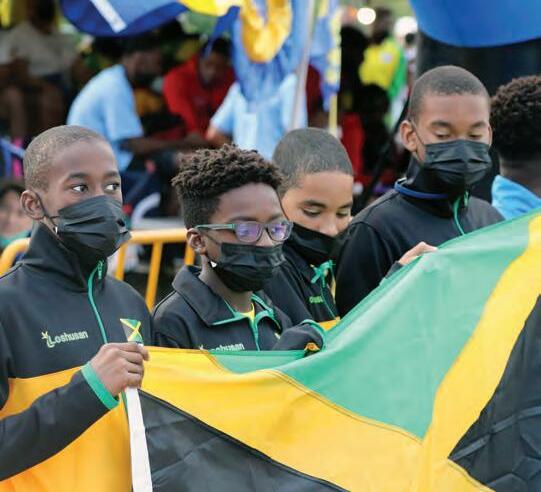
afternoon finals sometimes didn’t end until 10 or 11 o’clock in the evening. There wasn’t a lot of time for Adlai to do his schoolwork, so we were really grateful for all the time his teachers put in when he returned to campus, making sure that he caught up on his assignments.”
All three boys returned to campus in April and enjoyed all that spring offers on The Point. They all competed in the Charles C. Gates Invention & Innovation Competition, and they also added new sports to their repertoire; Cameron and Adlai played on the Fourths Lacrosse Team, while Cole was on the Reserve Tennis Team.
Shortly before this magazine went to press, Eleanor Brown sent us an update: “Cameron represented Jamaica at the Caribbean Goodwill Games in Port of Spain, Trinidad in August, where he won a silver medal in the 200-meter individual medley and a bronze medal in the 100-meter butterfly. In addition, he won three additional silver medals for his participation in several relay events.” Congratulations, Cameron! We look forward to following all the boys’ progress again this winter! r

45
at left: Cousins Cameron Brown ’25, Adlai Nixon ’25, and Cole Brown ’25; at right: Adlai at CAriFtASwimming and Open Water Championships in April
An Ode to Spring Athletics

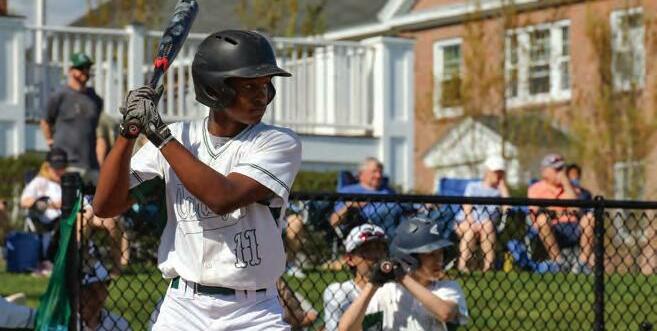

This spring, more than ever, the score of the game, the tally of wins and losses, had little impact on the positive vibe of afternoon athletics. For the first time in three years, athletes had a full schedule of competitions; a renewed sense of purpose and joy fueled their training and competitions. Was it statistically the best season on record? Probably not. Did rain—and snow—result in canceled games? Definitely. But on the days when the sun came out and the boys scattered across The Point in the late afternoon sunlight to sprint and throw and pitch and catch and cradle, it was enough just to be playing together.
There’s a magic that happens as the athletes build a family through the course of a season. Sometimes in the first few days of a season, I fear that some of the boys will phone it in, but with few exceptions the boys give it their all for the joy of the game, and on a regular basis I walk away from practices and games with a smile on my face.
 – DAnIELLE FEDELE
– DAnIELLE FEDELE
46FroM MArrion FieLD


47



48FroM MArrion FieLD
At Cardigan, there is a lot of support for all our teams. The community cheers just as loud, if not louder, for the reserve players as the varsity players.
– MEg LLoyD
At Cardigan, we ask the boys to participate in competitive play. They might not be as strong or fast as others, but at their level they are able to contribute. And that’s exciting. Not every boy leaves Cardigan ready to play on a varsity team, but they will all be valuable to any team they join because they have competitive competence. They understand the pace and flow of the game; they can handle the ups and downs and control their emotions; they have solid skills, and they can bounce, not just physically but mentally as well.
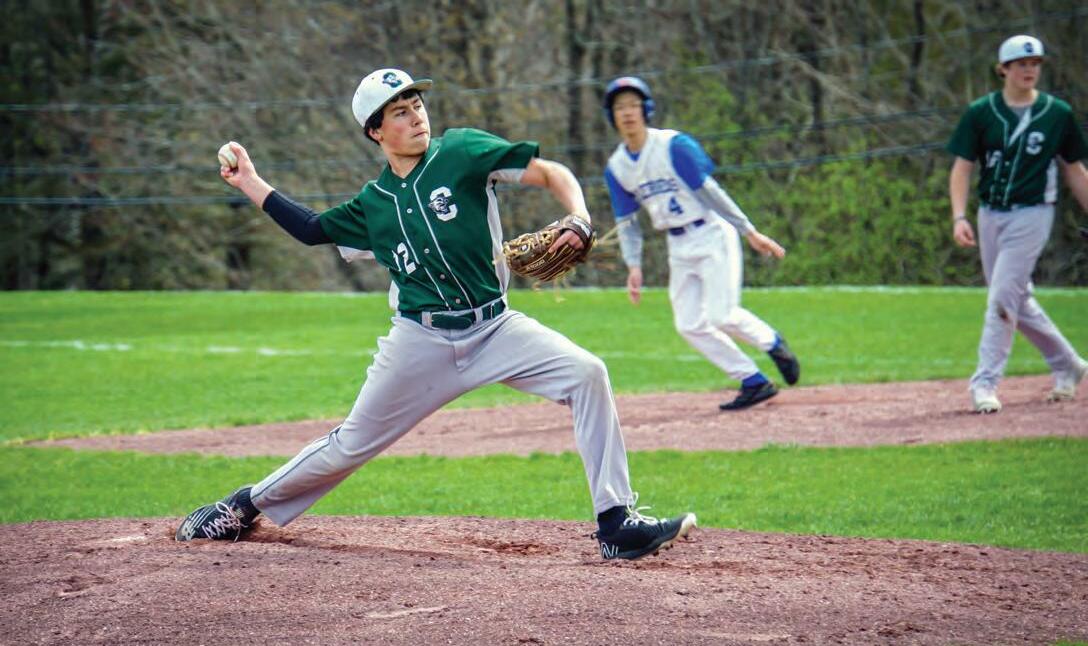
 – ALLAn KrEuzburg
– ALLAn KrEuzburg
P’14,’17
49
hiStory’S mySterieS
Photo Forensics
By JuDith SoLBerg
Cardigan Mountain School’s archives collection brings together familiar and not-so-familiar items to give us a better understanding of the School’s past. In this recurring Chronicle feature, the Cardigan community helps to shed light on both discoveries and puzzles from the archives. This fourth set contains photos taken in Cardigan classrooms, both inside and out.

Your help, shared via the website and by email, has already helped us to identify students from every era. As always, whether you have a solution or just want to celebrate successful sleuthing, you can check in regularly at cardigan.org/historysmysteries to watch our progress. The online galleries, established in 2020–21 in honor of Cardigan’s 75th Anniversary, are part of the Cardigan Archives’ growing collection of digital resources. r

50hiStory’S MySterieS
d1 d2









51 d3 d4 d5 d6 d8 d7 d11 d10 d9
founders path
Cardigan’s Board Approves Strategic Plan
New
by chris adams
When Cardigan’s previous strategic plan and the corresponding capital campaign concluded during the School’s 75th anniversary year of 2020, Head of School Chris Day P’12,’13 described both as “wildly successful.”

With those results—and the successful framework behind it—as a foundation, Cardigan took the first step toward building a new plan in early 2021, when board committees met through Zoom to per-
form a Strength-Weakness-OpportunityThreat (sWot) analysis within their individual areas of responsibility. Shortly thereafter, a decision was made that, despite the challenges and risks of the coVid-19 pandemic, it would be critical to continue this process in person both to create a fully-informed plan but also to establish and strengthen the relationships between Cardigan stakeholders.
A three-day retreat was planned in Park City, Utah, where board member Jory Macomber and his wife Martha P’12 were
52founders path
Plan Focuses on People, Programs, and Financial Stability
amazing hosts to a representative group of twenty-five board members, administrators, faculty members, and parents.
The agenda asked participants to consider several topics including vision and goals, people, program, and financial sustainability. Presentations on each area considered past and current trends and the results of the SWOT analyses conducted earlier. After each presentation, attendees broke into smaller groups in which they were instructed to brainstorm ideas in the context of “What’s next for Cardigan?” A final workshop asked participants to reach consensus on the highest priority items for inclusion in the next strategic plan.
During the weekend, the group came to the realization that Cardigan’s goals for diversity, equity, and inclusion (DEI) were philosophically intertwined with the School’s mission and Core Values, and that significant work lay ahead at the board level, within the School’s adult community, and among our student body. There was further recognition that success would require a multifaceted approach: to build and maintain a diverse student body, the School would also need to recruit and retain diverse faculty and staff; and to do both of these things would require a welcoming, informed, and inclusive culture.
Similarly, the group identified three components of the Cardigan curriculum— the Gates Invention & Innovation Program, Personalized Education for the Acquisition of Knowledge and Skills (PEAKS™), and Cardigan Outdoor Recreational Experience (CORE)—both for their academic value as well as vehicles through which Cardigan can support the health and wellness of our community. There was clear consensus that the enhancement and expansion of these signature Cardigan programs would need to be a priority.
By the end of the weekend, it was agreed that Cardigan’s new strategic plan—
with the exception of an Athletic Master Plan and Residential Master Plan—would focus on people and programs. Many felt this a logical next step from the strong but flexible foundation of facilities and infrastructure provided by the School’s previous strategic plan and the corresponding Campaign for Cardigan 2020.
That campaign raised more than $60 million, and all in attendance believed that the success of a new strategic plan for Cardigan would require a similar or greater investment. It was agreed that increasing Cardigan’s endowment would be the path to long-term financial stability, allowing the School to continue its focus on mis-
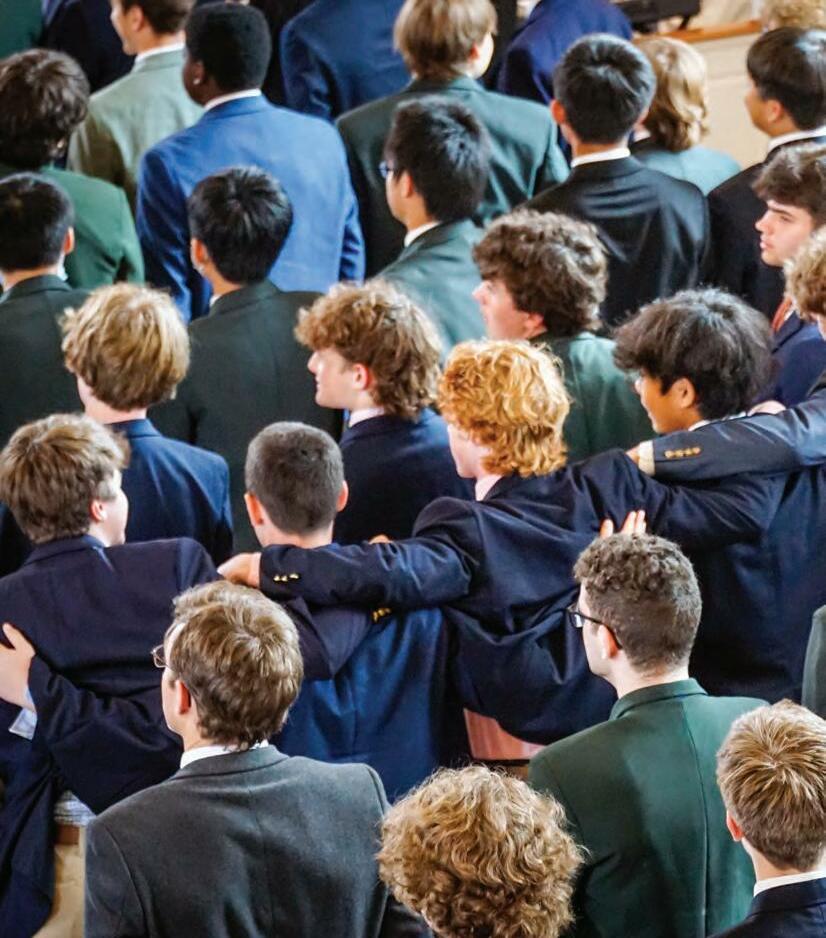
sion and core values rather than be forced to compromise in the face of financial pressures. As Board Chair David Gregory P’18 remarked at the close of the meeting, “We need financial freedom; it’s the key!”
In January of 2022, and after a thorough review of the work produced at the retreat, Cardigan’s Board of Trustees approved The Strategic Plan for Cardigan 2032. Cardigan wishes to thank the members of our community who contributed their time and wisdom to defining the School’s next strategic steps. To read the complete plan, please visit cardigan.org/strategic. r
53
Cardigan Welcomes New Trustees and Bids Farewell to Longtime Members
Cardigan’s Board of Trustees renews every first day of July, and this summer the School shared a deep gratitude for the dedicated service of Dr. Nabil Elkouh P’15,’17,’19,’22, Ping “Selina” Huang P’20, Clayton Johnson ’79, P’08, and Barbara O’Connell P’03 as their terms came to a close.
Two additional long-serving members, David Bradley H’13, P’78 and Burt McGillivray P’07,’09,’09, transitioned from regular board members to trustees emeriti alongside Diane Walllach H’16, P’06.
The School welcomed three new members: Doowhan Ko P’23, Alva H. Taylor P’22, and Daniel M. Zinsmeyer ’83.
doowhan Ko p’23
Doowhan Ko and his wife Hyunsun An are the parents of Jason Ko ’23 and his younger sister Chloe. The family resides in Seoul, South Korea.
Professionally, Mr. Ko is a founding member and managing director of GreensLedge Korea Ltd., an investment banking firm that provides placement and merger and acquisition advisory services to global investors. Prior to founding GreensLedge, Mr. Ko was a team leader at Woori Asset Management Co., Ltd. where he led the private equity team.
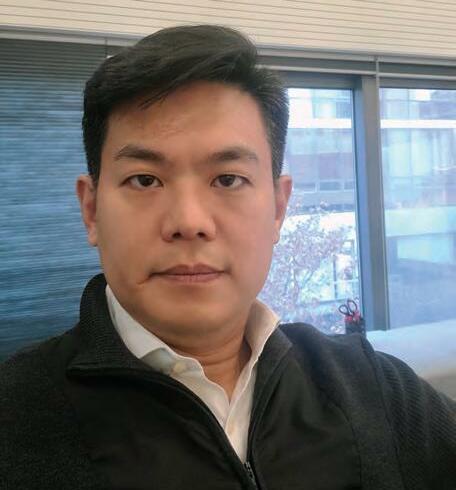
Before joining Woori in 2011, Mr. Ko was a senior manager at Macquarie Korea Opportunities Management and led the establishment of a KoFC-anchored fund specializing in infrastructure projects. Mr. Ko has also served as a manager in the corporate finance department of KpMgAdvisory in Seoul.
Mr. Ko earned a B.A. in business administration from Korea University and is also a CpA. In his spare time Mr. Ko enjoys spending time on the golf course.
daniel m. ZinSmeyer ’83
Mr. Zinsmeyer is a serial entrepreneur, an angel investor, and a champion of global environmental causes. Today, he serves as a board director for the Wrigley Institute for Environmental Studies at the University of Southern California, overseeing student programs for diverse populations and uSC’s relationship with the “living laboratory” on Catalina Island.
After graduating from Cardigan, Mr. Zinsmeyer attended Tabor Academy before matriculating to uSCand earning dual degrees in history and secondary education in 1991.
Mr. Zinsmeyer began his career by harnessing his passion for snowboarding to help build one of the nation’s top snowboard manufacturing companies, pioneering technology and design

54FounDerS pAth
David Bradley H’13, P’78 and Burt McGillivray P’07,’09,’09 Join Diane Wallach H’16, P’06 as Trustees Emeriti
From left to right, Doowhan Ko and Daniel Zinsmeyer ’83
innovation for virtually every outdoor equipment brand. Across the portfolio, Mr. Zinsmeyerled product design, board production, sales, and marketing. Later, in partnership with his brother, he joined The Big Print, a large format digital printing business. Serving mass retailers across the U.S., the company delivered “green” signage solutions and large-scale installations. The Big Print was a preliminary member of the Carbon Credit Exchange, a test facility for non-solvent corn ink and helped establish today’s best practices for environmentally sound production.
Mr. Zinsmeyer’s philanthropic interests include creating outdoor opportunities for disadvantaged youth through SoSOutreach, and serving in advisory roles for several adolescent mental health, environmental, and diversity, equity, and inclusion causes.
Mr. Zinsmeyer, his wife Sandra, and their three daughters reside in Seattle, Washington. An avid outdoorsman, he can be found spending time on the water, on the ice, and in the mountains.
alva h. taylor, ph.d. p’22
A thought leader in technology and strategy, Dr. Taylor interacts with a multitude of companies and influences the development of the next generation of technology business leaders. He currently serves as faculty director of the Center for Digital Strategies (CDS) at the Tuck School of Business at Dartmouth College. In this role, he has regularly advised and facilitated discussions between Cios for both U.S. Fortune 500 and global 500 companies. Dr. Taylor also serves on the council of advisors for riSeCareer Launch, an organization founded to assist early career professionals from underrepresented groups in the successful launch of their careers.
After earning bachelor’s and master’s degrees in industrial engineering as well as an MBA—all from Cornell University—he transitioned into the business world as a management consultant for KpMg. Looking to further integrate his engineering background and his business interests, he left the consulting world to pursue a doctoral degree at Stanford’s Graduate School of Business in organizational behavior. After completing his doctoral program, Dr. Taylor worked at the Kellogg Graduate School of Management before moving on to the Tuck School of Business at Dartmouth College.

Internationally, Dr. Taylor taught at the Solvay Business School in Brussels and spent a year in Singapore at inSeAD. Dr. Taylor also teaches in Dartmouth’s Healthcare Delivery Program and directs executive education programs for diverse entrepreneurs.
Dr. Taylor, his wife Dr. Gail Ayala Taylor, and their four children— Frances, Logan, Gabriel ’22, and Faith—live in New Hampshire. Dr. Taylor enjoys traveling and has visited more than thirty countries. r
Ph.D.
55
Alva H. Taylor,
alumni drive
Gates Competition Alumnus Receives U.S. Patent
It’s often the case that as a young person grows up, their passions and interests change as they learn new skills, develop relationships with different people, and encounter different life experiences. That has not been the case with Ben Ely’21; he’s been an inventor as long as he can remember.
When Ben was a seventh grader at Cardigan Mountain School in the spring of 2019, he had already developed an interest in applied sciences, and through the Charles C. Gates Invention & Innovation Competition, he invented a handhold for the side of a sailboat to help novice sailors right their capsized boats. His prototype won him a Patent Nod, an award that “allows the patentability of the student’s invention to be assessed by a law firm specializing in intellectual property law.”
When we last caught up with Ben in the winter of 2020, he had filed a provisional patent application with the U.S. Patent Office, and was working on another prototype with a model shop associated with the University of Vermont. Unfortunately, CoViD-19 significantly slowed his progress, both in creating prototypes and in the application process. In fact, the model shop with which Ben was working at uVM switched all their attention to designing respirators, and Ben had to settle for developing his ideas in the virtual world with computer-aided design (CAD). On Tuesday, June 14, however, everything finally came together and Ben’s SailAid officially received a patent, U.S. Patent No. 11358686.
“The patent is intentionally broad to include several different designs,” explains Ben. “One design is meant to be installed during the boat’s manufacturing and another is meant to be temporary. That’s been one of the hardest parts to figure out—how to adhere the SailAid to a boat without using harmful adhesives. One idea I’m working on involves using a suction cup.”
Recently, Ben was able to gain access to the use of a 3D printer and has a prototype he hopes to test at the Dartmouth Yacht Club on Mascoma Lake in New Hampshire where he sails during the summer.
Ben’s passion for inventing, however, has not been limited to his patent work. After graduating from Cardigan, he chose The Hotchkiss School for his secondary education and has been involved there in founding and growing the school’s robotics team—The Hotchkiss eFXGearcats. In its first year, the team had 10 students, which grew to 20 last year and placed fourth at the 2022 Connecticut state semi-finals. Ben is also on the school’s varsity sailing team.
What’s next for Ben? He plans to continue to work on his prototypes; as a junior at Hotchkiss this fall, Ben will have access to the school’s eFXLab and can participate in independent study opportunities during which he can continue his work on the SailAid. He also hopes to connect with Hotchkiss alumni to work on the marketing and sales of his invention.
When you find your passion, when you know what fuels your inner fire, follow it. Ben has. r
facing page: (background) The schematic showing SailAid in operation, from the patent granted to Ben in June of 2022; (insets, from top to bottom) the SailAid as an aftermarket accessory, the SailAid molded into the hull of new boats, and the SailAid in action.
56ALuMni DriVe




57
A Musician’s Journey from Cardigan to Carnegie Hall
Jim Taylor ’66 still loves to play the classic hits of the ’60s and ’70s that first piqued his interest in music as a young boy at Cardigan, but his career as a composer, conductor, and professor has allowed him to explore so much more of the “wide tapestry of music.”
 By ChriS ADAMS
By ChriS ADAMS
In the summer of 1969, Jim Taylor was among the many young people at the Woodstock festival. Like so many teenagers in the late 1960s—a period he describes as his lost years—Jim was searching, though for exactly what he was not sure. In the fall of 1971, bearded and wearing deerskin fringe, he stuck out his thumb and headed west with five dollars in his pocket. For a while he lived with “some hippies” in Steamboat Springs, Colorado, until a friend had to go to Florida and he tagged along for the ride.
A few years earlier, Jim, a good student, had skipped two grades before enrolling at Cardigan as a ten-year-old seventh grader. He started a student band that played not only on campus, but also for a dance at a local high school. After graduation he attended Mount Hermon School (now Northfield Mount Hermon), but things did not go as well there as they had at Cardigan and he left. He finished high school, but his life was beginning to lack direction, and he was spiraling downhill.
After arriving in Boca Raton, Florida, in January of 1972, Jim remembers, “Two cute Christian girls invited us to an allnight church event in West Palm Beach. I saw in the eyes of those young people a security and happiness I lacked, and after a sunrise message on the beach, I raised my hand and was baptized into the Christian faith.”
Jim spent the next five years leading the music program at a Christian coffee house and attending Florida Atlantic University, where he earned a degree in music composition in 1977. It was at FAu
that he recalls realizing that pop music “is just a tiny speck on the wide tapestry of music.” He married a young woman in the coffee house band and pursued graduate studies, first at North Texas State University (now unt), and then at the University of Miami, where he earned a master’s degree in studio writing and production in 1982. His home church in Boca Raton invited him to become its director of music, beginning a 24-year career serving five different churches in Florida, Colorado, and Alabama. During this time, he also founded the Jacksonville Children’s Chorus, a community arts organization that now serves over 500 young people in a number of choirs in the Jacksonville, Florida, area.
By the time his children were grown, Jim’s work had been published by Oxford University Press, Hinshaw Music, and other publishers, and he had twice conducted the Kyiv Symphony Orchestra and
58ALuMni DriVe
Chorus in Ukraine. Jim had become interested in teaching music at the college level, and with a fellowship offered by the University of Alabama, he was able to study music full-time. He completed his doctorate in choral conducting in 2012, shortly after beginning his collegiate teaching career as director of choral activities at Kilgore College in Kilgore, Texas.
It was after conducting the choral/orchestral work Carmina Burana that Jim stumbled upon the Cambridge Songs, eighty-three Latin poems contained in an eleventh-century manuscript housed for three centuries at the Cambridge University Library.
Inspired to set these poems to music, Jim composed four 25-minute suites of
Cambridge Songs for choir and orchestra over the next several years. He conducted the first suite in Kyiv in 2018, the second at Carnegie Hall in 2019, the third in Texas in 2021, and the fourth at L’eglise de la Madeleine in Paris in June 2022. For the Carnegie Hall performance, Jim was thrilled that Beverly Wakely H’01, P’70,’73,’75 and her son Charles ’70 drove down from Maine to attend the concert. He is scheduled to conduct at Carnegie Hall again in June 2023.

Today Dr. Taylor is director of fine arts and professor of music at LeTourneau University in Longview, Texas. Now in his sixth year, Jim shares that it is a perfect fit for him, as he is encouraged to express his faith as he directs his choirs and teaches
his classes. Rehearsals are times of enthusiasm, hard work, fun, and camaraderie as the singers strive together to prepare for performances marked by beauty and artistic integrity. On weekends he plays guitar and sings hits from the ’60s and ’70s at local wineries and coffee houses. “I know all these songs—the Eagles, Paul Simon, James Taylor, the Beatles,” he says.
“People my age go crazy for them. So much fun!”
Jim credits Cardigan for teaching him to live within structure and sharpening his ability to write and think critically. He recalls fond memories of Norman and Beverly Wakely and is extremely grateful for what the School added to his joyful life! r
59
Dr. Jim Taylor ’66 conducting at La Madeleine in Paris, June 2022
Weekends are precious. Pulled in multiple directions, we all seek to balance work and play—time for family and friends, passion projects, adventuring, sleeping late, catching up on household chores. The way we choose to spend our weekends says a lot about what is important to us. And that’s what makes Cardigan’s annual Alumni Hockey Game so special. It’s a day once a year when Cardigan alumni set aside all other weekend commitments and come back to The Point to play hockey.
An Important Alumni Tradition Returns: Pond Hockey on Canaan Street Lake
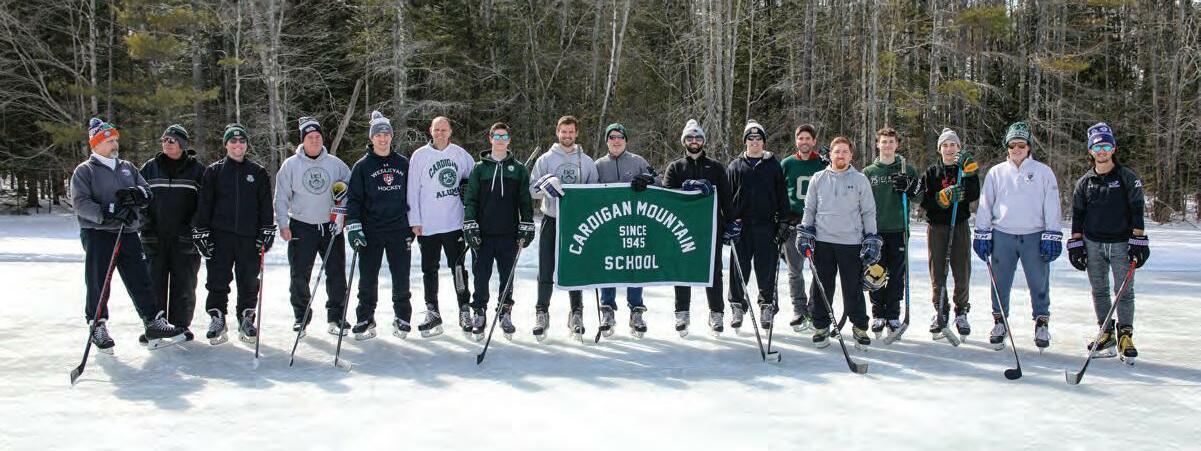
This year’s game took place outside on Canaan Street Lake under sunny skies. In plastic lawn chairs around a smokey fire pit, alumni pulled their gear from hockey bags bearing the logos of many well-known high school and collegiate teams. Technically, these boys and men are amateurs, but their passion for hockey runs deep and reflects the countless hours they have spent in practices and games on the ice.
Skates, gloves, and helmets on, they made their way down the winding path of ice to the rink, where Director of Alumni Relations Jer Shipman ’00 was ready to form two teams, randomly dividing the players’ sticks into two piles. Strangers became
teammates, the old guard joined recent graduates; it seemed as if every decade of Cardigan hockey was represented.
Of course, pond hockey is nothing like its fast-paced indoor version with high boards to corral the puck and a full-sized goal to accommodate air-borne slapshots. Pond hockey is a slower game in which periodic breaks are needed to retrieve the puck from snow banks and no one seems certain of the score.
It also wouldn’t be pond hockey if the ice was perfect. As the temperature rose above freezing on that Saturday, the ice softened and even the best skaters found themselves sprawled across the rink and
launched out of bounds. Five minutes into the second half, the game was stopped for fear that serious injury might ensue. Fortunately, Cardigan takes pond hockey seriously and had not one but two rinks on the lake. Drifting snow was cleared from the edges, benches and goals were moved, and the game continued.
An equally important part of the Alumni Hockey Game occurs on the sidelines as current and former faculty gather, eager to connect with their former students. Even for those who have been faithful participants of the game, it was two years ago that they all last met on the ice (last year’s game was canceled due to the pandemic).
60Alumni Drive
above and facing page: Scenes from this year’s pond hockey game
In that time a new generation of Cougars has been born; they were there too, watching from the bench and playing in the snow.
When the second rink became too rough for skating as well, players called the end of the game and made their way to the CORE Cabin for ribs, sliders, and an ample platter of Cardigan cookies—yes, they’re as good as you remember them. Awards went to MVPs Juno Cowan ’20 and Al Stevenson’00, and trustee Jon Wakely’75 gave a history lesson on Cardigan hockey, highlighting alumnus and former varsity coach Bruce Marshard’64, P’20 who convinced former Headmaster Norm Wakely H’91, P’70,’73,’75 to take a chance on admitting a handful of boys from an old rink called Hockeytown, USAin Melrose, Massachusetts.


As the sun dipped behind the trees and the temperature began to drop, the boys, both young and old, trudged back along
Alumni Athletes in Action
Remember those Cougars you used to love to watch on game days, the ones you missed when they graduated? Ever wonder where they ended up? We have answers! While we do not have room to list every collegiate athlete to graduate from Cardigan, here’s what we know about the most recent Cougars who are playing on collegiate teams. If you, or someone you know, isn’t listed, please let us know and we’ll add you to the list!
baseball
Cole Beck ’19Lynn University
Matty Grabmann ’19University of Oregon
Sam Harris ’19Babson College
Will Hindle ’19University of Rhode Island
Christian Moore ’18 University of Tennessee
Trey Parker ’16Plymouth State University Ryan Sweeney ’18Ventura College
basketball
Max Gregory ’18 Denison University
AJ Lesburt ’19Brown University
Jalin Sinclair ’16Lehigh University
Mo Bamba ’14nba(2018 to present)
football
Malcolm Bussey ’18St. Francis Xavier University
Jon Saklad ’16Wake Forest University
hockey
Drew Bavaro ’15University of Notre Dame
TJ Beaver ’16Saint Michael’s College
Matthew Connor ’17Curry College
Andrew Noel ’16Ferris State University
Christian Powers ’16Amherst College
Gavin Bayreuther ’09nhl(2021–present) Reilly Walsh ’14nhl(2021–present)
lacrosse
Jack Almeida ’18Trinity College
Souley Ballo ’16Hobart College
Ben Baroni ’19Villanova University
CJ Baroni ’16Bucknell University
Jack Bayreuther ’17St. Lawrence University
Owen Borek ’15Providence College
Ro Bryan ’15St. John’s University
Peter Callahan ’15Sacred Heart University
Tyler Conklin ’17Loyola University
Jake Dulac ’15University of Massachusetts Amherst
Peter Gilbert ’18Trinity College
Ben Gill ’16Bentley University
Kade Goldberg ’18Georgetown University
James Green ’18Hobart College
Joseph Jordan ’15The College of Wooster
Bear Lockshin ’16Princeton University
Christian Moore ’18Hamilton College
Tucker Mullen ’18University of Virginia
Matt Pecora ’17Trinity College
Nick Pecora ’17Lehigh University
Henri Pfeifle ’16Drexel University
Aidan Philie ’17Bowdoin College
Austin Philie ’16Bowdoin College
Brandon Reilly ’17Skidmore College
Thomas Stull ’18Richmond University
Gunnar von Hollander ’18Connecticut College
Barrett White ’18Syracuse University
soccer
Kyle Graber ’16St. Lawrence University
Tucker Williams ’15College of the Holy Cross
wrestling
Ethan Kreuzburg ’17Muhlenberg College
the snowy path to the parking lot behind the big red barn. They loaded up their cars with soggy gear and tired children—some with some newly acquired alumni swag and an extra cookie or two. They took with them
their memories of a perfect New England afternoon and the connections they made with their brothers—a worthwhile way to spend a Saturday afternoon. r
61
Choosing His Own Role: Carlos Garcia
Joins the Conversation on Climate Change
A quick look at the LinkedIn profile of Carlos Garcia ’07 reveals a simple truth about his character: following a short “About” paragraph, he finishes with “If I don’t see an opportunity for growth, I make one.” This perspective has meant that his career hasn’t always followed a direct path, but as one opportunity has led to another, Carlos has intentionally chosen a life of service and stewardship to the environment.
“Middle school wasn’t the easiest time for me; it’s tough to get middle school kids to be nice to people who are different from them,” begins Carlos Garcia, who was born in San Antonio, Texas but was raised all over the world. “But I remember seeking refuge in Jamie Funnell’s office and making the first community garden with Allan Kreuzburg. Cardigan gave me independence and helped me gain confidence in my convictions, sticking true to what I was thinking.”
After graduating from Cardigan, Carlos attended Mercersburg Academy, where he ran track, played soccer, and was the captain of the debate team. “I loved arguing,” he says. “At the time, I was planning on being a trial lawyer.”
But that all changed when he went to Africa between high school and college and decided that he didn’t want to be stuck behind a desk for the rest of his life. He fell in love with photography and switched his focus to photojournalism.
His trajectory changed again when he was at Goucher College, where he received a bachelor’s degree in environmental studies. He remembers watching Cool It, a 2010 documentary film based on the book Cool It: The Skeptical Environmentalist’s Guide to Global Warming by Danish political scientist Bjørn Lomborg: “Watching the movie made me realize that climate change is the most pressing issue facing our species that people misunderstand and/or know nothing about. It made me want to become an
expert on climate change and an advocate for marginalized people.”
A year in the Peace Corps followed during which he lived in Peru and worked for the municipality of Huari, creating the city’s first free community education program, developing the city’s first tourism website— aimed at the promotion of its environmental tourism—and establishing a reforestation program focused on native plant species.
“During my time in Peru, I began to understand that one of the biggest causes of climate change is involved in generating, storing, using, and disposing of energy,” he explains. “It was clear to me I needed to understand the energy grid and the government policies that impact and inform its development and evolution.” So for the past five years, Carlos has worked to educate himself—earning a master’s in energy policy from the University of Pennsylvania and a certificate of law from the University of Pennsylvania Law School. He’s also worked for a number of non-profit organizations in the eastern U.S.—at Harvard University as a research scientist, for the city of Boston, Massachusetts as an energy policy analyst, and for the New York City Environmental Justice Alliance as an energy policy planner.
In May 2021, Carlos moved to Washington, D.C. and is now working for Bloom Energy, a company dedicated to developing technology to make clean, reliable energy that is affordable to all. “I’m now a federal policy manager and spend most days understanding current legislation, ana-
lyzing policies, and providing feedback where I can,” he says. “I talk with policymakers and try to form coalitions with like-minded businesses.”
That’s how Carlos found himself at the 26th UN Climate Change Conference of the Parties (Cop26) in Glasgow, Scotland last November. “Each morning, as I stood patiently in line, waiting to enter Glasgow’s Scottish Event Center, I wondered who was standing next to me: a climate activist, a president of a nation, a leader of an indigenous tribe, or a company executive?” Carlos wrote in an article on Bloom Energy’s website. “And what role could I play to help them reduce their carbon and greenhouse gas emissions now while empowering them to achieve complete decarbonization in the future? …Being a ‘first-time Cop-er,’ I found myself in awe of the meaningful conversations and connections one can make by simply showing up and being authentic. When you listen to someone with respect, empathy, and positivity, the world of possibilities opens to you.” Among his most notable conversations, Carlos says he was able to connect with American businessman Bill Gates and White House National Climate Advisor Regina McCarthy.
“There’s a harmony in the issues we are fighting,” he concludes. “Now more than ever there’s an awareness and commonality of issues. We have the knowledge; we now need to find the funding and develop the policies to support and incentivize change.”
62ALuMni DriVe
If you ask Carlos to pinpoint a moment in his career that he is most proud of, he will tell you about a series of environmental videos and lectures he set up when working in Peru. The free program was focused on educating the Huari on various environmental issues. “Climate change is one of the biggest changes impacting the people of Huari,” Carlos explained in an interview in 2017. “They don’t really understand it. They don’t understand why seasons are changing out of pattern, why animals that used to live near Huari aren’t there anymore, and why their crops are not growing as efficiently as they used to.”

A goal of the lecture series was to encourage female leadership in science. “I wanted to let the women and girls of Huari
know that their end goal could be more than being a wife or being in traditional ‘women jobs.’ They could study sciences and math as well,” Carlos explained. “A week later a university student came up to me after the video lecture and told me that she realized she could understand ‘tough’ scientific concepts that were explained in the videos and by the lecturers, and it made her decide to change her studies from tourism to environmental engineering, something that she was always told was a ‘man’s job’ and that she would never understand.”
Carlos added: “By simply showing some videos and hearing amazing professionals talk, we’ve now changed this girl’s future, hopefully for the better. If during my time on this earth I can change just one per-
son’s life for the better, I know I will have left this world a better place than when I came into it. That’s my ultimate goal.” (Lux, Christopher. “How an Environmental Education Program is Changing a Peruvian Community.” Lux Writing Center, January 14, 2017, luxwritingcenter.com/ tag/huari/. Accessed April 27, 2022.)
It’s a lofty goal but one he has already accomplished and probably will again, a hundred or a thousand times over. r
63
Carlos Garcia ’07 at the 26th UN Climate Change Conference of the Parties (Cop26) in Glasgow, Scotland last November
In Search of Pavé: e Ride of Ansel Dickey’s Life
By Jer ShiMpMAn ’00
Ansel Dickey ’10 has roots that go back to the founding of Cardigan. His great uncle, Jerald Newton (after whom Newton House is named) joined the board of trustees in 1951 and served the School until 1987. With that kind of legacy, it might seem like Ansel’s path to Cardigan would have been paved long before he applied, but Ansel’s road to The Point, and almost everywhere else he’s gone, has been by way of a rougher surface; and that’s just the way he likes it.
Ansel is the owner of Vermont Overland, a company that promotes adventure travel experiences by way of a flagship, 54-mile cycling race over Vermont pavé, that is, unmaintained dirt roads through and around small towns in the Green Mountains. The gravel cycling scene is exploding and Ansel’s race draws thousands of participants each year, eager to explore the pastoral and picturesque mountains, farms, and fields of rural New England. This spring, Ansel and his team introduced a running event as well, the Overland Trail, which was equally popular in its inaugural year. Ansel says, “We got our start by believing in the transformative power of all-surface exploration. It’s the best way to race, run, ride, and ultimately experience a landscape.”
This couldn’t be a more fitting project for Ansel whose path is never easy and always enlightening.
Ansel came to Cardigan from Truro, Massachusetts. His mother, a school psychologist in the public school system on Cape Cod, wasn’t sure that Ansel was well-suited for middle school at home, and looked to her family’s ties in Canaan for Ansel’s seventh-grade year.
Upon arriving at Cardigan, Ansel fell in love with ski racing. He bonded with former coach Gus DiMaggio and thrived on the mountain. Though Ansel was enjoying
the Cardigan experience as a whole, skiing became everything and academics were secondary. By the end of his eighthgrade year, while most classmates were looking ahead to senior year before heading off to traditional prep schools, Ansel sought a different direction. He applied to Killington Mountain School (KMS), a ski academy where he could dedicate even more time to racing.
KMSwas a winter-only program, meaning Ansel would attend public school at home on Cape Cod in the fall and spring, and spend the winters in Vermont, racing full-time. While he continued to find a home on the snow, without the familiar structure and routine he’d come to know at Cardigan, he struggled to balance his studies and school life. After a string of aggregate offenses, and a few bad decisions, Ansel was asked to leave KMS.
Back home on the Cape, missing the snow, the consequences for his actions began to sink in, and Ansel hit a low point. Worse, he’d sustained an injury that made a return to competitive skiing uncertain. Looking for an outlet, Ansel took up cross training on a bike and showed some potential. He says, “I had been dabbling in cycling, and I knew I was good, but I didn’t know that I was very good.” He was indeed very good, and it caught the attention of a faculty member
at his old school at just the right moment. KMSwas expanding its offerings, and the coach of their new road cycling program invited Ansel to try out for the team.
Ansel jumped at the opportunity. After a summer devoted to training, and with a reawakened determination to succeed, he entered the first series of competitions. Though excited, he was realistic, and as a rookie competing against seasoned athletes from top prep schools, he was uncertain of how competitive he might be.
He won every single race he entered.
Ansel says, “That was the first time I had felt success in any sort of organized sports setting. I remember saying, ‘This is awesome!’ and that got me back on the straight and narrow from there on out.”
He reapplied to KMSwith the proposal to be a day student in the school’s new yearround academic program; he would give up skiing and focus on cycling. With his renewed attitude and focus, they welcomed him back. Ansel’s domination continued; by the end of his senior year, he had made the u.S.A.National Cycling Team, and he was weighing the options between full scholarship offers from multiple colleges and professional contracts. Still never beholden to traditional routes, Ansel passed on college and went pro.
64ALuMni DriVe
at left: The Overland runs through the New England towns of Woodstock, Pomfret, Taftsville, and West Hartford, VT, where working farms, covered bridges, and livestock dot the landscape; above: Ansel in 2014, riding with his first pro contract with Specialized
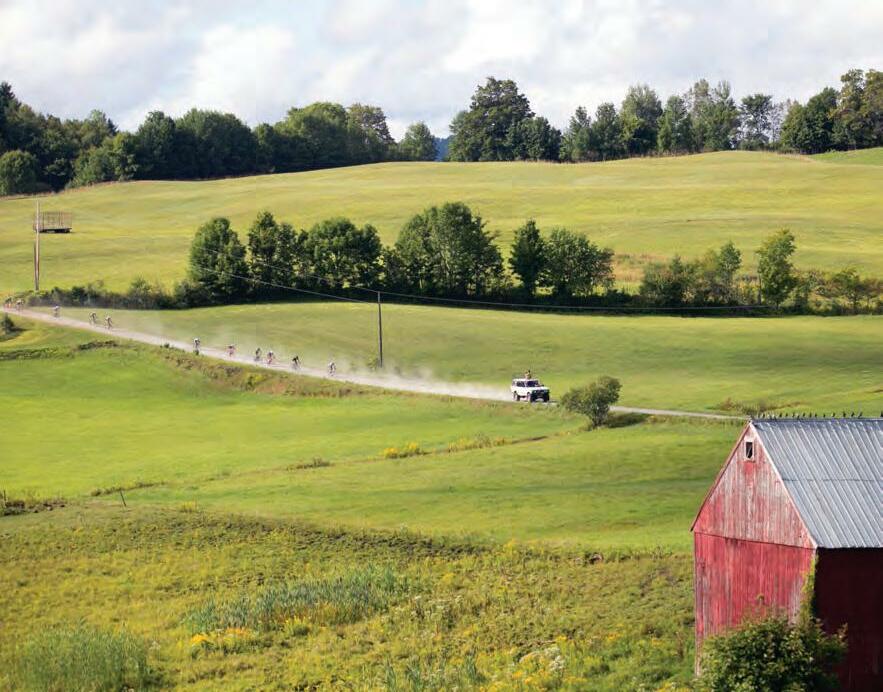
He raced all over the world, saw successes, and life was good. But just a few years into the experience, he began to have concerns about this track. Ansel was in his early 20s watching athletes nearing the twilight of their professional careers living an existence not much different from his. Cycling is a unique sport in which the best riders may not reach their peak until their late thirties, but Ansel was hoping for a more settled life long before that. Though he was making a decent living, and there was plenty of upside left in his athletic career, Ansel once again made an unexpected turn; he left the professional circuit and started blazing another new trail.

Having a natural knack for photography, Ansel began managing social media for small businesses. Social media jobs transformed into marketing and advertising work, those jobs developed into
photo and film production, and in 2017, Vermont Social was born—a production company dedicated to telling the stories of brands and athletes in the endurance and outdoor and adventure worlds through film and photography.
Now, at 27, Ansel owns two thriving companies—registration for the last Vermont Overland was open for just over 10 minutes before it sold out, and millions of viewers have watched his work with Vermont Social. To say his product is in demand is a vast understatement. Ansel talks about keeping up with the ever-increasing workload and managing everything:
“I remember being upset at Cardigan, because it was so intense for such a young person, but looking back now, there is nothing better to learn when you’re that age. It’s supposed to be tough. It’s real life stuff. You need to learn those values from a young age… It’s a
consistency thing; being willing to grind and put in work. You learn that at a place like Cardigan and, especially through endurance sports.”
Ansel readily admits he is not sure about his next direction, how he’ll grow his companies, or if he even wants to; having ambition and goals is important, but so is enjoying the ride. What’s next for Ansel is hard to predict. What isn’t is that he’ll find a way to get there that will surprise you. Ansel’s greatest strength might be in exploring alternate routes— uncharted stretches of proverbial Vermont pavé that will make his journey a bit more difficult, but all the more inspiring—and for someone with the soul of a gravel cyclist, that’s exactly the point. r
65
cardigan connections
1:
2:
In Memoriam
Cardigan Mountain School has been notified of the passing of the following alumni, former board members, former faculty, and former staff:
r Mr. Branden R. Cooper ’86: April 11, 1971–December 26, 2021
r Mr. John Michael Fetscher (Faculty): August 27, 1943–April 15, 2022


r Mr. Thomas I. McClintock ’70: January 9, 1954–July 25, 2022
r Mr. Juan J. Ortiz-Miron ’82: January 24, 1966–August 1, 2021
r Mr. Zachary J. Pace ’02: April 25, 1986–May 19, 2022
r William “Bill” Edward Seely, Jr. ’59: February 5, 1943–July 30, 2022
r Dr. Gilbert R. Suitor ’60: March 27, 1945–January 26, 2022
1966
Jim Taylor shared that he and his wife, Karen, have been married for forty-six years and have three children and six grandchildren. He enjoys playing tennis and racquetball and working out.

1968
Thomas Moran shared, “My wife Alice and I recently retired in the California desert to the city of Indio after 20 years in San Clemente, CA, preceded by 21 years with the U.S. Navy. Our two grown daughters are in the L.A. area, and we now have two
wonderful grandsons. Life has been and continues to be very good to the Tom and Alice Moran family. We are very very thankful indeed!”
1971
Ken Lary writes, “My wife Eileen and I welcomed our first grandchild in November 2021. Our daughter Ally and her husband Bert blessed us with a little girl, Jacqueline Kate Oaks. She is named after my mother, Jackie Lary H’04, P’69,’71, who worked in the CMSBusiness Office for 36 years.”
66Cardigan ConneCtionS
Former Head of School Dave McCusker ’80 and wife Steff, joined by Beverly Wakely, her son Jon Wakely ’75, and Bruce Marshard ’64;
2 1 3
Dan Zinsmeyer ’83, Charlie Kissel ’10, and Head of School Chris Day in Seattle; 3: Ronn Bronzetti ’89 and his wife Sara with Christy Budnick, the Global CEO of Berkshire Hathaway HomeServices
1980
Former Head of School Dave McCusker and wife Steff H’16, P’09,’10 joined Beverly Wakely H’01, P’70,’73,’75, her son Jon Wakely ’75, and Bruce Marshard ’64, P’20 for Commencement in May.



1983
Chris von Jako wrote, “May 5, 2021 was an extremely exciting and proud moment as BrainsWay ‘lit up broadway’ again by ringing the naSdaQclosing bell, highlighting Mental Health Awareness Month. I have had a lot of exciting jobs during my medical device career, but the

last 30 months have been truly special and very rewarding; my team and I continue to bring increased awareness to mental health and effective treatments, like our noninvasive Deep tMS treatment for depression, anxious depression, oCd, and smoking addiction. I was honored to be joined at the podium with several of our customers, successfully treated patients, and members of the BrainsWay team in nYC, as well as virtually in Israel, and all over the U.S.” Ben Brewer writes, “Hi Cardigan friends and community. I hope this finds you well. Life keeps moving forward. I married Keely Knoche on April 16, 2022. We live happily in Colorado
Springs with her two kids. My son Jacob just finished his sophomore year at Berklee College of Music. My small real estate company in Breckenridge continues to thrive. Please reach out: benjamin_brewer@yahoo.com!”
Dan Zinsmeyer was elected to the Cardigan Board of Trustees in the spring of 2022. On a recent trip to Seattle Chris Day P’12,’13 connected with Dan and Charlie Kissel ’10 at a Kraken ice hockey game.
1985
Current student Magnum Hudkins ’24 connected with William McKenna, who invited him to sit
in on a business meeting in Naples, FL.
1989
Ronn Bronzetti shares, “My wife Sara and I moved to Wolfeboro, NH, from Boston five years ago. We formed a husband and wife real estate team called the Lake Winni Team. Our focus is on residential real estate for buyers and sellers around New Hampshire’s Lakes Region.”
1991
67
Dave Pucci owns a construction business in Philadelphia and still keeps in touch with Cardigan
1: Magnum Hudkins ’24 and William McKenna ’85 at the Ritz-Carlton in Naples, FL; 2: Hannu ’92 and Gilbert ’22 Lignell during the Alumni Tie Ceremony at Cardigan’s Commencement; 3: Chris von Jako ’83 was invited to ring the closing bell at the NASDAQoffices in NYCthis spring;
2 3
4
4: Enrique ’95 and Enrique ’22 De Alba during the Alumni Tie Ceremony at Cardigan’s Commencement
1
3
1
friends in the area. Dave has five children from two to 18 years old.

1992
Alumni dads Hannu Lignell, Gustavo Struck, Francisco Artigas ’94, and Enrique De Alba’95 reunited at Cardigan and each gave their graduating sons—Gilbert ’22, Gus ’22, Pancho ’22, and Enrique ’22 their alumni ties during a ceremony before Commencement.

1994
John D’Entremont accepted a new job serving as principal of the Lyme, NH school district, commencing in July 2022.

1995
After living and working abroad in the Netherlands, Nigeria, and Ghana for most of his career, Trey Ragno and his family are back in Texas and looking forward to settling in Corpus Christi. After managing restaurants for famous chefs in Boston and NYC, Shawn Chippendale
moved home to Texas and began a photography business. He is now a food, drink, and event photographer based out of Houston. His work can be seen at shawnchippendalephotography.com.
1996
Bart Fromuth writes, “I’m running an energy firm in southern New Hampshire called Freedom Logistics. We are about 30 employees strong and growing. I’m very thankful that business has remained up despite the trying times. I was recently brought on to the board of directors at both Clean Energy NH and the McAuliffe-Shepard Discovery Center. I’m very excited about both. I previously served two terms in the New Hampshire Legislature from 2014–18. At present, I reside in Bedford, NH, with my wife Mary Ellen and two daughters, Madelyn and Alexandra.”
Chris Payne’s firm Payne Capital Management continues to do well and has been featured on CNBC’s Fast Money. When not in the office, Chris enjoys sailing and has been spending a
68CardigaN CoNNeCtioNs
1: Gustavo ’92 and Gus ’22 Struck during the Alumni Tie Ceremony at Cardigan’s Commencement; 2: Francisco ’94 and Pancho ’22 Artigas during the Alumni Tie Ceremony at Cardigan’s Commencement; 3: Brooks (five) and Tucker (three), sons of Mike Bannon ’98 following in their father’s footsteps 2
lot of time in Newport, RI for competitions.
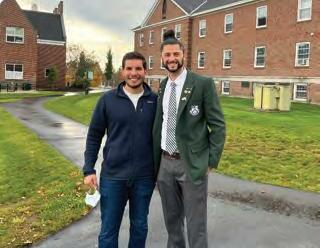
1998
Mike Bannon writes, “After moving from Boston to Denver in 2016, my wife and I now have two boys, Brooks (five) and Tucker (three). Brooks just wrapped up his first hockey season, and Tucker will likely play next year. I would love to connect with other CMSalumni if anyone is ever in Denver.”


1999
Mac MacVittie writes, “I’m humbled to share that this past year I was promoted to lieutenant colonel in the USaFand have been serving as the director of operations for the 458th Airlift Squadron at Scott Air Force Base, IL. In this capacity I lead a group of 75 pilots and 14 aircraft responsible for the transportation of our republic’s military and civilian leadership around the United States. Even more note-
worthy: my wife Amanda and I welcomed our third child (another daughter) this past December, and she is perfect in every way.”
2000
Mikal McCalmont is working in the hospitality industry in Boston. He and his wife Rae are the proud parents of a threeyear-old boy named Enzo.

Tim Frazier is working as an engineer in Portsmouth, NH. He
served as a judge in Cardigan’s 14th Annual Charles C. Gates Invention & Innovation Competition in May.
James Tautkus is living in Ketchum, ID, and continues to enjoy playing music. His current band, the Pisten Bullys, an altcountry band with a catalog of original songs, has built a strong following in southern Idaho and continues to grow in popularity.
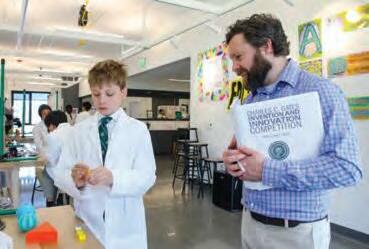
69
2 1 3 4 5
1: Tim Frazier ’00 and inventor David Balshen ’25 at Cardigan’s Gates Competition this spring; 2: Alvaro Aguirre ’06 and friend Jon Castillo ’06 on campus this spring; 3: AJ Bourdon ’09, Cam McCusker ’10, and Jason Cahoon ’12 after a Cardigan vs. Eaglebrook hockey game; 4: Former CMS coach Robbie Barker ’97 and Gavin Bayreuther ’09 in Boston; 5: Chris Cyr ’06 with twins Hugh and Oliver
2002
Hamdi Cavusoglu is working for a VC firm as a tech analyst. He recently took a tour of Europe which included an extended stay in Turkey.
2005
Courtney Lockwood graduated from the University of Denver School of Business in the spring of 2021, and is now working for the Everwest Corporation in Denver.
2006
Chris Cyr is living and working in Nashville. He and his wife Celine welcomed twins (Hugh and Oliver) in November 2021.
Alvaro Aguirre visited campus from Monterrey, Mexico, and caught up with his old friends. Alvaro is married and has a one-year-old girl named Ema. He started a company in Monterrey that produces flavorings and spices for food.
2009
After a Columbus Blue Jackets game in Boston, Gavin Bayreuther caught up with former CMScoach Robbie Barker’97, who is currently the head hockey coach at Lawrence Academy.


AJ Bourdon and Jason Cahoon ’12 are both coaching hockey at Eaglebrook School. While interviewing for jobs in New York City, Jason Sohn visited campus from South Korea for the first time since graduation


and reunited with many old friends.
2011
Alex Brennan is working for Goldman Sachs in Philadelphia, PA. Alex has been working with young Cardigan alumni interested in finance and has helped several land internships on Wall Street.

70Cardigan ConneCtionS
1 2 3 4 5
1: Max Gilbert ’13 and Cardigan tennis coach Eddie Ramos following a school fair during which Max was representing Salisbury; 2: Cardigan faculty member Jarrod Caprow with Jason Sohn ’09; 3: Reilly Walsh ’14 with pucks from his first NHLgame and first point; 4: Justin Biela’14; 5: Trey Parker ’16, a junior at Plymouth State University who pitches on the school’s baseball team
2012
Spencer Cookson is running a thriving outdoor business in Sheffield, MA. Berkshire Bass offers guided fishing trips and sells bait, tackle, and apparel (berkshirebassin.com).
2013
Austin Franklin captained the Emerson lacrosse team in his senior year and became the first



player in college history to sign a name, image, and likeness deal. Austin partnered with a local deli to raise funds for a memorial scholarship that supports college athletes. Austin, who has more than 300,000 YouTube followers and 11 million TikTok views, joined the social media team of Draft Kings after graduation.

Max Gilbert is working as director of weekend activities and is a development associate at
Salisbury School. Max returned to his alma mater after graduating from St. Lawrence University in 2021.
2014
Reilly Walsh made his nHLdebut for the New Jersey Devils on April26, 2022, and tallied an assist in his first game. Reilly is the seventh Cougar to play in the nHL.

Yifu Mu, who recently graduated from Georgetown, returned to Cardigan to speak at Commencement, sharing stories of his volunteer work in Cambodia and lessons learned as a Chinese immigrant living in America.
In May, Justin Biela graduated Summa Cum Laude from Florida State University and was commissioned as a second lieutenant in the United States Air Force. He began his combat pi-

71
4 1 3 2 5 6
1: Austin Franklin ’13 with his Emerson lacrosse teammate and owners of Archie’s Deli in Boston; 2: Congrats to Hugo Turcotte ’15, who will play for the Diables Rouges in the upcoming 2022–23 season; 3: Yifu Mu ’14, who was Cardigan’s Commencement speaker, with Head of School Chris Day and Board Chair David Gregory; 4: Souley Ballo ’16, Owen Borek ’15, and James Greene ’18 connecting after a lacrosse game; 5: Pablo Rocha with Santi Errejon ’16, JM Gomez ’15, and Alejandro Valenzuela ’15 in Madrid; 6: Jack Bayreuther ’17 and Alec D’Orio ’17 after a St. Lawrence University lacrosse game
lot training at Sheppard Air Force Base near Wichita Falls, TX in September.
2015
Hugo Turcotte is playing goalie for the Diables Rouges of Briançon, France. The team plays in


the Ligue Magnus, the top professional hockey league in France.
Pablo Rocha caught up with Mexican alumni Santi Errejon’16, JM Gomez, and Alejandro Valenzuela on his trip to Spain over Cardigan’s March break.


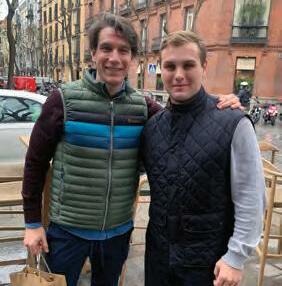
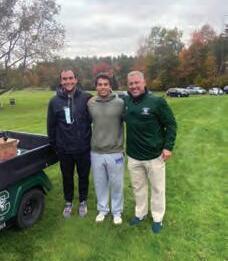


2016
State
2017

72Cardigan ConneCtionS
Souley Ballo ’16 and James Greene ’18 (Hobart) reunited with Owen Borek (Providence) during a preseason lacrosse game.
Trey Parker transferred from Roanoke College to Plymouth
University, where he’s doing well and getting more time on the mound as a pitcher for the Panthers.
On a visit home to see family in Spain, Pablo Rocha connected
2 3 1 4 5 9 7 6 8
1: Oliver Cookson ’17, a member of the Fitchburg State University Falcons Hockey Team; 2: Pablo Rocha and Alec D’Orio ’17 in Madrid; 3: Alijah Lovelace ’19 with Cougar basketball fans at Suffield Academy; 4: Cougar alumni on St. Paul’s hockey team: Conley Bohan ’21, Dylan Biggs ’20, Bryce Terry ’20, Sam Sibold ’19, and Jack Roberts ’21; 5: Tony ’19, Rodrigo ’22, and Diego ’20 Carrandi; 6: Isaac Abbott ’19, Cam McCusker ’10, Ryan Frost, Mac Wang ’21, Drew Philie ’06; 7: Hector ’18 and Nico ’22 Flores during Cardigan’s Alumni Tie Ceremony at Commencement; 8: Jack Glowacki ’19 with Pablo Rocha and Ed Ramos; 9: Quinn Cepiel ’19 with Cardigan faculty James Forse and Ryan Frost
with Alec D’Orio, who was spending a semester in Madrid.
Jack Bayreuther just completed his freshman year at St. Lawrence, where he played on a very successful lacrosse team that earned a bid into the nCaa tournament for the first time since 2017.

Oliver Cookson played on the Fitchburg State University Falcons hockey team while also making dean’s list in his freshman year.
2018
Hector Flores attended Commencement and presented his brother Nico ’22 with his alumni tie.


2019
AJ Noel and Kyle MurraySmith’20 (KUa) faced off against Cooper Warrington (Holderness) in the nePSaC hockey quarter finals. KUawent on to win 4-2.

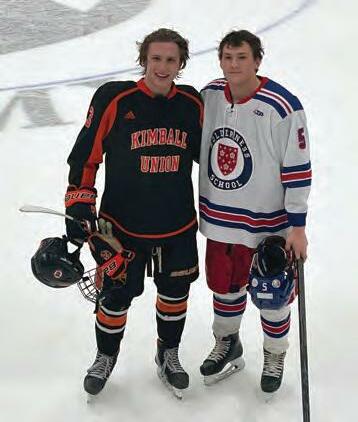

The 2021–22 St. Paul’s hockey team featured five Cougars: Conley Bohan ’21, Dylan Biggs’20, Bryce Terry ’20, Sam Sibold, and Jack Roberts ’21

73
2 1 3 6 7 5 4
1: AJ Noel ’19 and Cooper Warrington ’19 after the NEPSACquarter final game; 2: Tinashe Muhlauri ’20 with Cardigan faculty Eric Escalante; 3: Hector ’20 and Daniel ’22 Benavides during Cardigan’s Alumni Tie Ceremony at Commencement; 4: Caden ’20 and Spencer ’22 Hutchinson during Cardigan’s Alumni Tie Ceremony at Commencement; 5: Rick and Nate ’20 Johnson, Jason Jiang ’20, and Bob Low following the 135th Groton vs. St. Mark’s Game; 6: The Class of 2020, along with faculty and parents, reunited in June and found a break in the clouds to enjoy a sunset hike, which they missed in the spring of 2020. Pictured here: Deegan Blasko, Diego Escalante, Caden Hutchinson, Dylan Gorman, Jack Marshard, Jason Jiang, Connor Pollard, Nate Johnson, Zach Hawthorne, Chris Day, Aiden Thede, and Lucas Ding; 7: Diego ’20 and Mateo’22 Escalante during Cardigan’s Alumni Tie Ceremony at Commencement
Members of Cardigan’s Varsity Basketball Team connected with Alijah Lovelace, who now plays at Suffield Academy.
Brothers Tony ’19 and Diego Carrandi ’20 came to Commencement and presented their younger brother Rodrigo ’22 with his alumni tie.
Ben Fenner graduated from Westminster School in the spring. Before heading to college, he is working the salmon
season on a commercial fishing boat out of King Salmon, Alaska.
2020
Jason Jiang and Nate Johnson met in the 135th playing of the St. Mark’s vs. Groton football game. Former faculty members Rick Johnson and Bob Low were on hand for the post-game photo.

Juno Cowans joined fellow alumni hockey players on


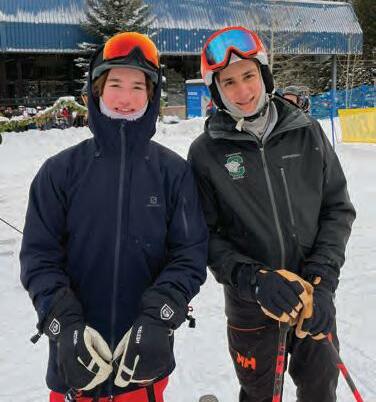
Canaan Street Lake in March and won the MVPaward. Juno is doing well and enjoying Exeter, where he will be a junior this fall.
Members of the Class of 2020, Caden Hutchinson, Diego Escalante, and Hector Benavides, attended Cardigan’s Commencement and presented alumni ties to their graduating brothers: Spencer ’22, Mateo’22, and Daniel ’22

A hardy group of hikers including alumni, faculty, and parents joined Chris Day P’12,’13 for a sunset hike up Mount Cardigan, to make up for the missed opportunity in the spring of 2020 when all students were working from home.
2021
Mac Wang is at Deerfield Academy and rows varsity crew. The team enjoyed an undefeated season and won the New England Championships. r
74Cardigan ConneCtionS
2 1 3 4 5
1: Andie Muhlauri ’21 with Cardigan faculty Hal Gartner; 2: Danny Valenti ’21, Tanner McFaul ’21, Taewon Moon ’19, and Sean Wang ’21 with faculty Cheryl Borek; 3: Jeff Kang ’21 with Cardigan faculty Josh LeRoy and Kris Langetieg; 4: Jack Diemar ’21 and Wil Castillo ’20; 5: Zach Miles ’21, Mark Anstiss ’21, and Tedy O’Keefe ’21
1: Alumni gathering on the steps of Clark-Morgan Hall on the Cardigan campus to welcome the Class of 2022 and present alumni ties to the newest graduates; 2: Joe Burnett ’95, Jon Joy ’62, Chris Day, Graham Clough ’71, and Dan Barton ’01 in Denver; 3: Jeremiah Shipman ’00, Noah Fosse ’12, Tyson Greenwood ’93, Joe Burnett ’95, Chris An ’14, Ryan Mitchell ’92, Jeff Koo ’15, Joon Lee ’20, Hamdi Cavusoglu ’02, Park Burger ’92, and Zach Turner ’93 at a Cardigan Career Network event in New York City; 4: David Pucci ’91, Chris Payne ’96, Joe Burnett ’95, Alex Brennan ’11, Rich Gwinn’90, and Matt Tucker ’91 in Philadelphia, PA; 5: Max Rand ’14, Sean Donahue ’95, Alan Stevenson ’00, Diego Ramonfaur ’10, Mikal McCalmont ’00, Jamie Esdaile ’90, Nate Gilbert ’08, Ron von Jako ’81, Joe Burnett ’95, Jeremiah Shipman ’00, and Chris Kennedy ’79 at a Cardigan Career Network event in Boston; 6: Mario Zambrano ’95, Cody Moerer ’95, Joe Nelson, Jeremiah Shipman ’00, Shawn Chippendale ’95, Joe Bergner ’77, Asche Ackerman ’75, Joe Burnett ’95, Wayne Wickman ’78, Anderson White ’76, Chris Day, Craig Johnson ’70, and Nancy Beck in Houston, TX






75
2
1 3 4 5 6
Parting Shot

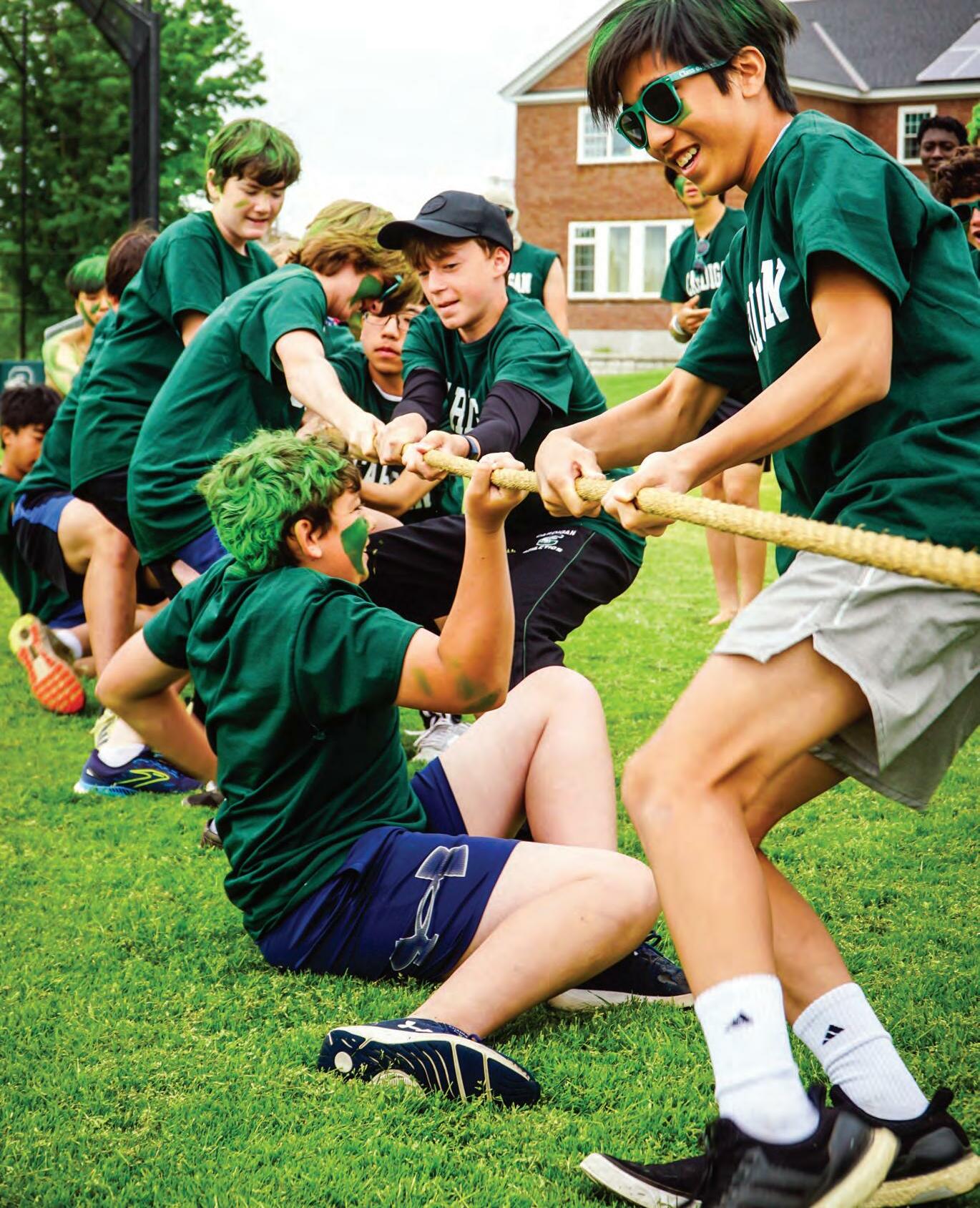
76
the annual fund for cardigan
“the other fella” is the theme for the 2022–23 school year— an abbreviation of coach jim marrion’s familiar adage, “help the other fella.”
At Cardigan, this is more than a saying. It’s a way of life, and our first Core Value, Compassion, charges us to consider those around us before ourselves. The Cardigan Way of leading through service and putting others first has built a culture and community in which middle school boys can learn, grow, and thrive. Your assist to the other fella through an annual fund gift keeps us on mission and sustains the people, programs, and traditions that make Cardigan special.

annual fund gifts help us:
r Open Our Doors: Your support increases our ability to provide financial aid awards to deserving boys and families from all backgrounds.
r Grow and Inspire: The Annual Fund supports members of our faculty as they pursue ongoing professional development as teachers, coaches, and advisors—gaining experience which they bring back to campus.
r Focus on What’s Important: The Annual Fund covers the day-to-day operating costs of Cardigan. Your support frees us to focus on that which is most important—the education of the boys.
This year, we aim to raise $1.15 million for the Annual Fund, and we rely on the entire community of alumni, parents, faculty, staff, and friends to help us meet that goal.
make your gift to cardigan’s annual fund today at www.cardigan.org/giving.
questions? contact jeremiah shipman ’00 at 603.523.3601 or jshipman@cardigan.org



cardigan mountain school 62 alumni drive canaan, new hampshire 03741-7210 nonprofit us postage paid manchester, nh permit no. 724












 Christopher D. DayP’12,’13 Head of School
Christopher D. DayP’12,’13 Head of School





































 – Preston Merrick ’22, – school leader
– Preston Merrick ’22, – school leader

















































 – DAnIELLE FEDELE
– DAnIELLE FEDELE






 – ALLAn KrEuzburg
– ALLAn KrEuzburg




















 By ChriS ADAMS
By ChriS ADAMS
































































